Jarčuška Benjamín
Evolutionary and Behavioural Ecology RG
Researcher

Ing. Jarčuška Benjamín, PhD.
Slovak Academy of Sciences
Institute of Forest Ecology
Evolutionary & Behavioural Ecology Research Group
Ľudovíta Štúra 1774/2
960 01 Zvolen
Phone: +421 907 074 072
Email: jarcuska@ife.sk
Research interests: ecology of plants and animals
Education:
- 2002 – 2007: Dipl. Ing. (MSc.) in Forestry, Faculty of Forestry, Technical University in Zvolen, Slovakia
- 2007 – 2011: PhD. in Ecology and Biodiversity Conservation, Institute of Forest Ecology – Slovak Academy of Sciences, Zvolen
Academic employment:
- Researcher, Institute of Forest Ecology, SAS (since 2012)
- Managing editor for journal Tichodroma (since 2012) and Slovak Raptor Journal (since 2014)
Projects:
Internships:
- 2010/3 – 2010/7: stay in Group of Terrestrial Ecology IRN-CCMA- CSIC (MNCN-CSIC), Madrid, Spain
2024 |
|
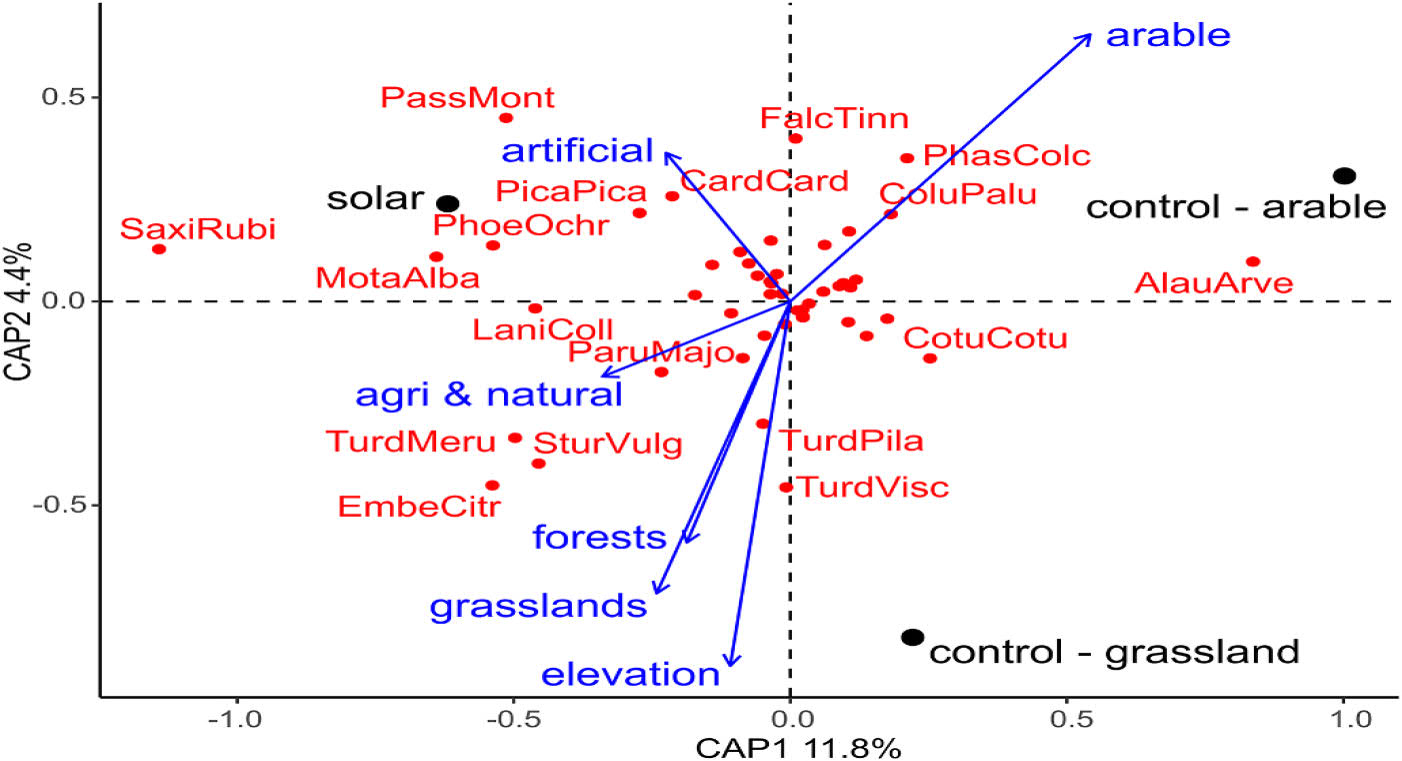 | Jarčuška, Benjamín; Gálffyová, Monika; Schnürmacher, Richard; Baláž, Michal; Mišík, Miloslav; Repel, Matej; Fulín, Miroslav; Kerestúr, Dušan; Lackovičová, Zuzana; Mojžiš, Marian; Zámečník, Matej; Kaňuch, Peter; Krištín, Anton Solar parks can enhance bird diversity in agricultural landscape Journal Article Journal of Environmental Management, 351 , pp. 119902, 2024, ISSN: 0301-4797. @article{Jar_u_ka_2024, title = {Solar parks can enhance bird diversity in agricultural landscape}, author = {Benjamín Jarčuška and Monika Gálffyová and Richard Schnürmacher and Michal Baláž and Miloslav Mišík and Matej Repel and Miroslav Fulín and Dušan Kerestúr and Zuzana Lackovičová and Marian Mojžiš and Matej Zámečník and Peter Kaňuch and Anton Krištín}, url = {http://dx.doi.org/10.1016/j.jenvman.2023.119902}, doi = {10.1016/j.jenvman.2023.119902}, issn = {0301-4797}, year = {2024}, date = {2024-01-01}, journal = {Journal of Environmental Management}, volume = {351}, pages = {119902}, publisher = {Elsevier BV}, keywords = {}, pubstate = {published}, tppubtype = {article} } |
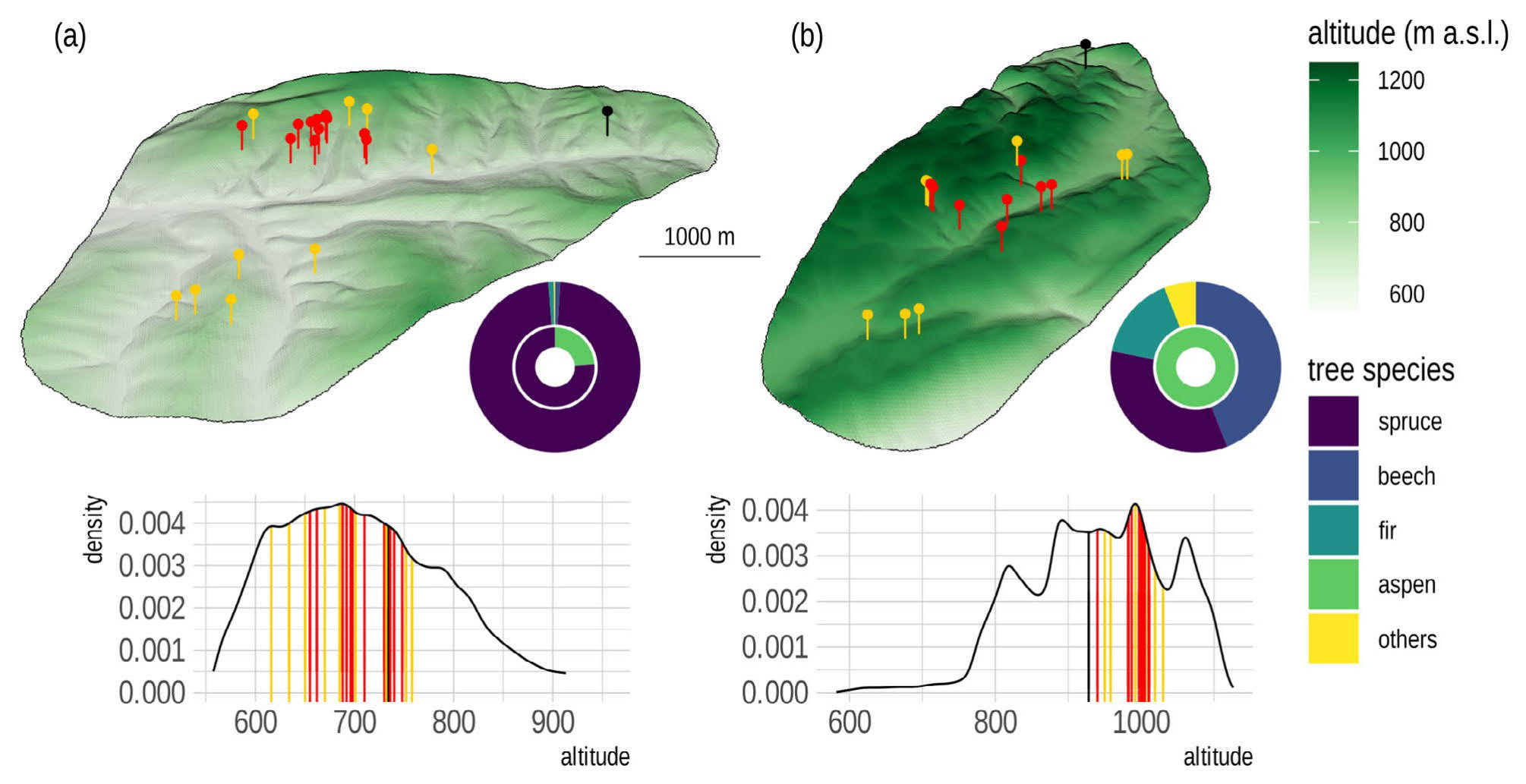 | Kaňuch, Peter; Lőbbová, Denisa; Bovin, Clémence; Ružinská, Romana; Jarčuška, Benjamín; Krištín, Anton; Kaňuchová, Andrea Maternity roosts of the giant noctule, Nyctalus lasiopterus, in preserved and disturbed forests of the Western Carpathians Journal Article Journal of Vertebrate Biology, 73 (24022), 2024, ISSN: 2694-7684. @article{Ka_uch_2024, title = {Maternity roosts of the giant noctule, Nyctalus lasiopterus, in preserved and disturbed forests of the Western Carpathians}, author = {Peter Kaňuch and Denisa Lőbbová and Clémence Bovin and Romana Ružinská and Benjamín Jarčuška and Anton Krištín and Andrea Kaňuchová}, url = {http://dx.doi.org/10.25225/jvb.24022}, doi = {10.25225/jvb.24022}, issn = {2694-7684}, year = {2024}, date = {2024-01-01}, journal = {Journal of Vertebrate Biology}, volume = {73}, number = {24022}, publisher = {Institute of Vertebrate Biology, Academy of Sciences of the Czech Republic}, keywords = {}, pubstate = {published}, tppubtype = {article} } |
2023 |
|
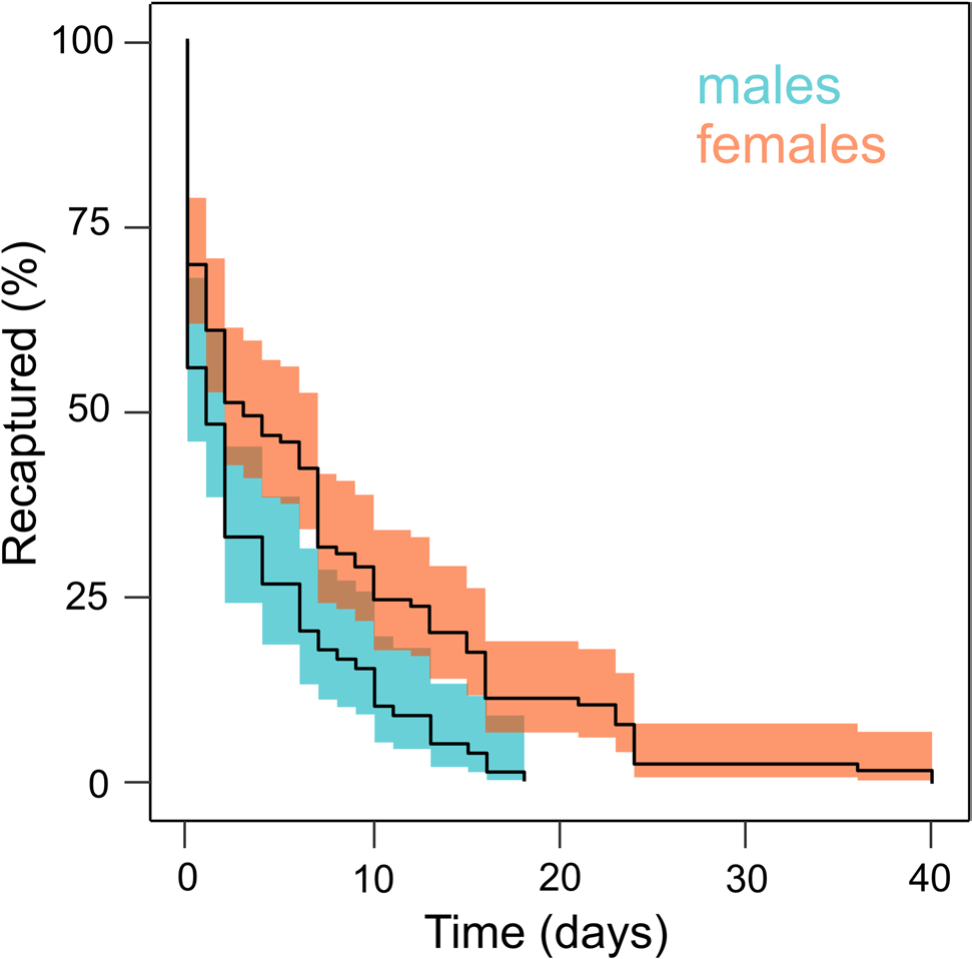 | Nuhlíčková, Soňa; Svetlík, Ján; Kaňuch, Peter; Krištín, Anton; Jarčuška, Benjamín Movement patterns of the endemic flightless bush-cricket, Isophya beybienkoi Journal Article Journal of Insect Conservation, 2023, ISSN: 1572-9753. @article{Nuhlíčková2023, title = {Movement patterns of the endemic flightless bush-cricket, \textit{Isophya beybienkoi}}, author = {Soňa Nuhlíčková and Ján Svetlík and Peter Kaňuch and Anton Krištín and Benjamín Jarčuška}, url = {http://dx.doi.org/10.1007/s10841-023-00529-0}, doi = {10.1007/s10841-023-00529-0}, issn = {1572-9753}, year = {2023}, date = {2023-10-01}, journal = {Journal of Insect Conservation}, publisher = {Springer Science and Business Media LLC}, keywords = {}, pubstate = {published}, tppubtype = {article} } |
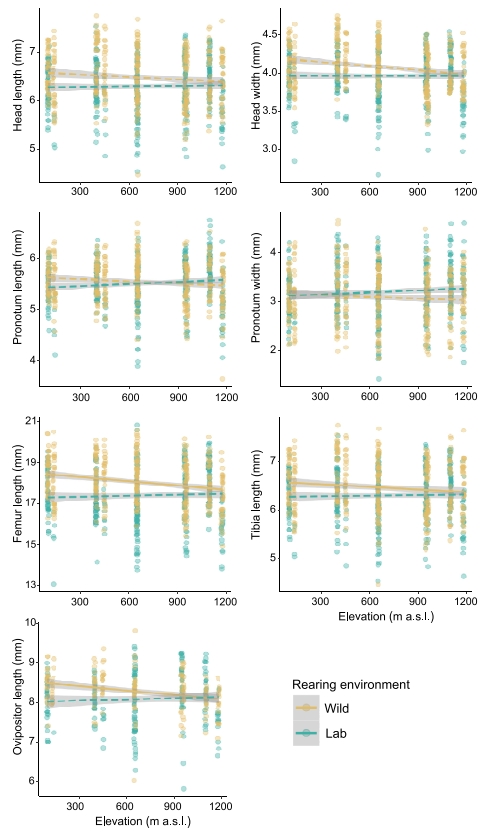 | Jarčuška, Benjamín; Krištín, Anton; Kaňuch, Peter Body size traits in the flightless bush-cricket are plastic rather than locally adapted along an elevational gradient Journal Article Evolutionary Ecology, 37 (3), pp. 509–530, 2023, ISSN: 1573-8477. @article{Jarčuška2023, title = {Body size traits in the flightless bush-cricket are plastic rather than locally adapted along an elevational gradient}, author = {Benjamín Jarčuška and Anton Krištín and Peter Kaňuch}, url = {http://dx.doi.org/10.1007/s10682-023-10231-x}, doi = {10.1007/s10682-023-10231-x}, issn = {1573-8477}, year = {2023}, date = {2023-02-02}, journal = {Evolutionary Ecology}, volume = {37}, number = {3}, pages = {509–530}, publisher = {Springer Science and Business Media LLC}, keywords = {}, pubstate = {published}, tppubtype = {article} } |
Jarčuška, Benjamín Large-scale spatial pattern of bird responses to a potential predator suggests that predator-specific mobbing is a plastic trait Journal Article Journal of Ethology, 41 (2), pp. 153–162, 2023, ISSN: 1439-5444. @article{Jar_u_ka_2023, title = {Large-scale spatial pattern of bird responses to a potential predator suggests that predator-specific mobbing is a plastic trait}, author = {Benjamín Jarčuška}, url = {http://dx.doi.org/10.1007/s10164-023-00781-6}, doi = {10.1007/s10164-023-00781-6}, issn = {1439-5444}, year = {2023}, date = {2023-01-01}, journal = {Journal of Ethology}, volume = {41}, number = {2}, pages = {153–162}, publisher = {Springer Science and Business Media LLC}, keywords = {}, pubstate = {published}, tppubtype = {article} } | |
2022 |
|
Potterf, Mária; Svitok, Marek; Mezei, Pavel; Jarčuška, Benjamín; Jakuš, Rastislav; Blaženec, Miroslav; Hlásny, Tomáš Contrasting Norway spruce disturbance dynamics in managed forests and strict forest reserves in Slovakia Journal Article Forestry, 96 (3), pp. 387–398, 2022, ISSN: 1464-3626. @article{Potterf_2022, title = {Contrasting Norway spruce disturbance dynamics in managed forests and strict forest reserves in Slovakia}, author = {Mária Potterf and Marek Svitok and Pavel Mezei and Benjamín Jarčuška and Rastislav Jakuš and Miroslav Blaženec and Tomáš Hlásny}, editor = {Dominik Thom}, url = {http://dx.doi.org/10.1093/forestry/cpac045}, doi = {10.1093/forestry/cpac045}, issn = {1464-3626}, year = {2022}, date = {2022-11-01}, journal = {Forestry}, volume = {96}, number = {3}, pages = {387–398}, publisher = {Oxford University Press (OUP)}, keywords = {}, pubstate = {published}, tppubtype = {article} } | |
Hrivnák, Richard; Jarčuška, Benjamín; Jarolímek, Ivan; Kochjarová, Judita; Májeková, Jana; Vantarová, Katarína Hegedüšová; Slezák, Michal Comparative diversity of vascular plants in black alder floodplain and swamp forests of Central European biogeographical regions Journal Article Biodiversity Data Journal, 10 , 2022, ISSN: 1314-2836. @article{Hrivn_k_2022b, title = {Comparative diversity of vascular plants in black alder floodplain and swamp forests of Central European biogeographical regions}, author = {Richard Hrivnák and Benjamín Jarčuška and Ivan Jarolímek and Judita Kochjarová and Jana Májeková and Katarína Hegedüšová Vantarová and Michal Slezák}, url = {http://dx.doi.org/10.3897/BDJ.10.e90281}, doi = {10.3897/bdj.10.e90281}, issn = {1314-2836}, year = {2022}, date = {2022-10-01}, journal = {Biodiversity Data Journal}, volume = {10}, publisher = {Pensoft Publishers}, keywords = {}, pubstate = {published}, tppubtype = {article} } | |
MIHÁL, Ivan; JARČUŠKA, Benjamín Epigeic harvestmen (Arachnida: Opiliones) of reforested Norway spruce forest stands in Slovakia: A case study Journal Article European Journal of Entomology, 119 , pp. 421–429, 2022, ISSN: 1802-8829. @article{MIH_L_2022, title = {Epigeic harvestmen (Arachnida: Opiliones) of reforested Norway spruce forest stands in Slovakia: A case study}, author = {Ivan MIHÁL and Benjamín JARČUŠKA}, url = {http://dx.doi.org/10.14411/EJE.2022.044}, doi = {10.14411/eje.2022.044}, issn = {1802-8829}, year = {2022}, date = {2022-01-01}, journal = {European Journal of Entomology}, volume = {119}, pages = {421–429}, publisher = {Biology Centre, AS CR}, keywords = {}, pubstate = {published}, tppubtype = {article} } | |
2021 |
|
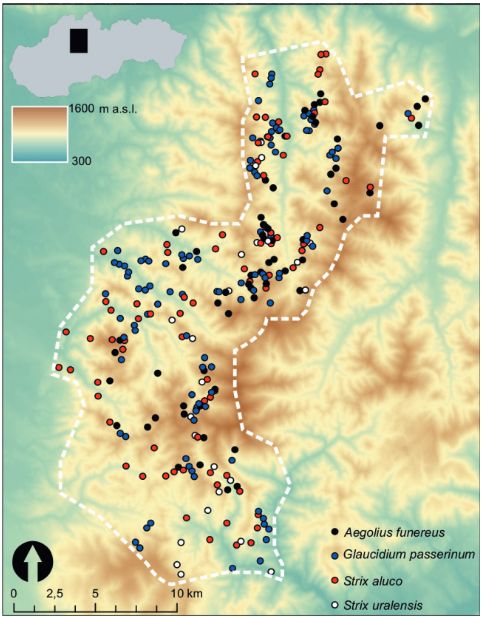 | Šotnár, Karol; Obuch, Ján; Pačenovský, Samuel; Jarčuška, Benjamín Spatial distribution of four sympatric owl species in Carpathian montane forests Journal Article Raptor journal, 14 (1), pp. 1-13, 2021, ISSN: 1337-3463. @article{Šotnár2021, title = {Spatial distribution of four sympatric owl species in Carpathian montane forests}, author = {Karol Šotnár and Ján Obuch and Samuel Pačenovský and Benjamín Jarčuška}, doi = {https://doi.org/10.2478/srj-2020-0002}, issn = {1337-3463}, year = {2021}, date = {2021-04-30}, journal = {Raptor journal}, volume = {14}, number = {1}, pages = {1-13}, abstract = {Knowledge about spatial distribution of owl species is important for inferring species coexistence mechanisms. In the present study, we explore spatial patterns of distribution and habitat selection of four owl species u Eurasian pygmy owl (Glaucidium passerinum), boreal owl (Aegolius funereus), tawny owl (Strix aluco) and Ural owl (Strix uralensis) u ranging in body mass from 50 g to 1300 g, with sympatric occurrence in temperate continuous montane forests in the Veľká Fatra Mts., Western Carpathians, central Slovakia. Locations of hooting owl males were surveyed between 2009–2015 in an area of 317 km2. Spatial point pattern analysis was used for analysis of owl distribution. Random patterns of owls’ spatial arrangement dominate at both intra- and interspecific levels within the studied area. Only intraspecific distribution of pygmy owls and interspecific distribution of Ural owls toward tawny owls exhibited positive associations. This discrepancy with other studies can be explained in terms of pygmy owlsy preference for high-quality nest sites and/or spatial clustering in their prey distribution, and due to aggressive behaviour of dominant Ural owls toward subdominant tawny owls, respectively. Moreover, we found considerable overlap in habitat preferences between owl species, considering stand age, stand height, tree species richness, distance to open area, elevation, slope, percentage of coniferous tree species and position on hillslope, although pygmy owls were not registered in pure broadleaved stands, Ural owls were not registered in pure coniferous stands, and boreal and Ural owls were more common on slope summits and shoulders than tawny and pygmy owls. The observed patterns of spatial arrangement might suggest developed coexistence mechanisms in these owl species; differences between studies may indicate complex interactions between intra- and interspecific associations and habitat quality and quantity, food availability and owl species involved in those interactions on a landscape scale.}, keywords = {}, pubstate = {published}, tppubtype = {article} } Knowledge about spatial distribution of owl species is important for inferring species coexistence mechanisms. In the present study, we explore spatial patterns of distribution and habitat selection of four owl species u Eurasian pygmy owl (Glaucidium passerinum), boreal owl (Aegolius funereus), tawny owl (Strix aluco) and Ural owl (Strix uralensis) u ranging in body mass from 50 g to 1300 g, with sympatric occurrence in temperate continuous montane forests in the Veľká Fatra Mts., Western Carpathians, central Slovakia. Locations of hooting owl males were surveyed between 2009–2015 in an area of 317 km2. Spatial point pattern analysis was used for analysis of owl distribution. Random patterns of owls’ spatial arrangement dominate at both intra- and interspecific levels within the studied area. Only intraspecific distribution of pygmy owls and interspecific distribution of Ural owls toward tawny owls exhibited positive associations. This discrepancy with other studies can be explained in terms of pygmy owlsy preference for high-quality nest sites and/or spatial clustering in their prey distribution, and due to aggressive behaviour of dominant Ural owls toward subdominant tawny owls, respectively. Moreover, we found considerable overlap in habitat preferences between owl species, considering stand age, stand height, tree species richness, distance to open area, elevation, slope, percentage of coniferous tree species and position on hillslope, although pygmy owls were not registered in pure broadleaved stands, Ural owls were not registered in pure coniferous stands, and boreal and Ural owls were more common on slope summits and shoulders than tawny and pygmy owls. The observed patterns of spatial arrangement might suggest developed coexistence mechanisms in these owl species; differences between studies may indicate complex interactions between intra- and interspecific associations and habitat quality and quantity, food availability and owl species involved in those interactions on a landscape scale. |
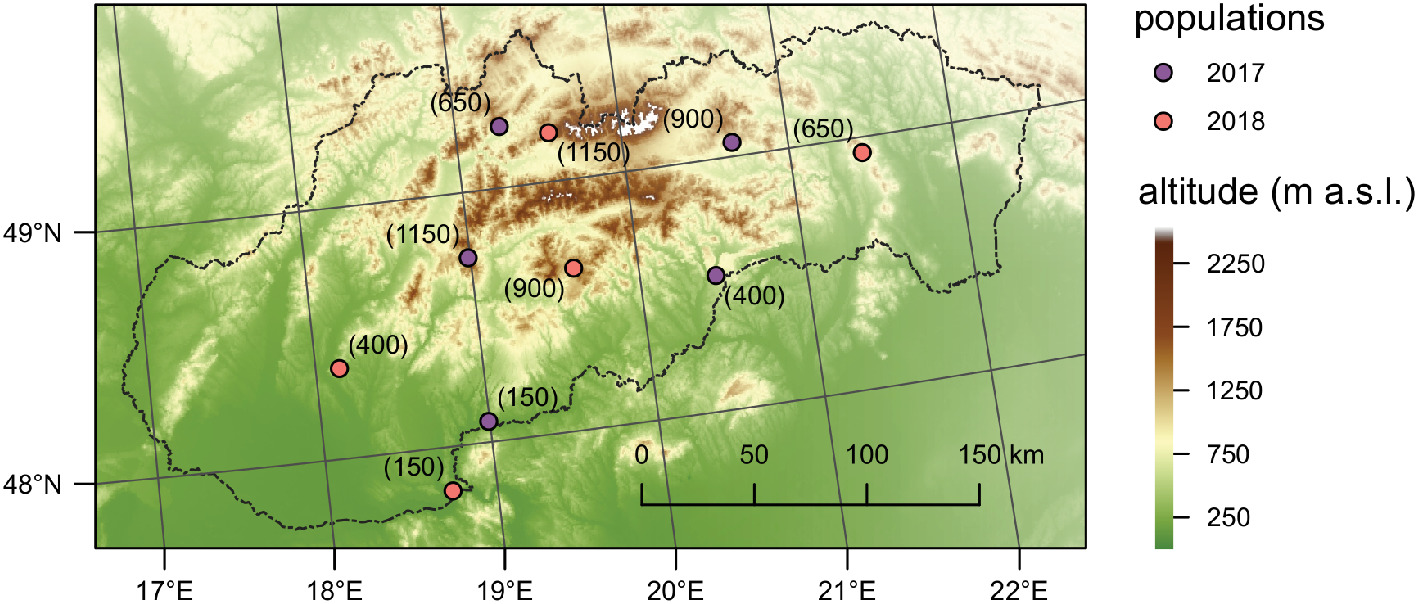 | Černecká, Ľudmila; Dorková, Martina; Jarčuška, Benjamín; Peter Kaňuch, Elevational variation in voltinism demonstrates climatic adaptation in the dark bush-cricket Journal Article Ecological entomology, 46 (2), pp. 360-367, 2021, ISBN: 0307-6946. @article{Černecká2021, title = {Elevational variation in voltinism demonstrates climatic adaptation in the dark bush-cricket}, author = {Ľudmila Černecká and Martina Dorková and Benjamín Jarčuška and Peter Kaňuch,}, doi = {https://doi.org/10.1111/een.12972}, isbn = {0307-6946}, year = {2021}, date = {2021-01-01}, journal = {Ecological entomology}, volume = {46}, number = {2}, pages = {360-367}, abstract = {1. Phenotypic plasticity and/or genetic adaptation may allow species to live in a variable environment. It has been shown that eggs of the dark bush-cricket, Pholidoptera griseoaptera, which experienced an insufficient warm treatment (shorter and/or colder), had a longer development time and hatched predominantly after the second diapause. 2. Given the broad distribution of this species from sea level to the timber line, we expected variation in voltinism along a climatic gradient. To reveal the role of natural selection in egg-hatching patterns, we compared different and unrelated populations sampled along a 1000 m elevational gradient in a common laboratory experiment. 3. In the same rearing microclimate, we found that populations from mountains had mostly a shorter life cycle, whereas semivoltinism prevailed in lowland populations. 4. This demonstrated the genetically underpinned local adaptation of this insect to harsh mountain environments with a shorter growing season determined by elevation.}, keywords = {}, pubstate = {published}, tppubtype = {article} } 1. Phenotypic plasticity and/or genetic adaptation may allow species to live in a variable environment. It has been shown that eggs of the dark bush-cricket, Pholidoptera griseoaptera, which experienced an insufficient warm treatment (shorter and/or colder), had a longer development time and hatched predominantly after the second diapause. 2. Given the broad distribution of this species from sea level to the timber line, we expected variation in voltinism along a climatic gradient. To reveal the role of natural selection in egg-hatching patterns, we compared different and unrelated populations sampled along a 1000 m elevational gradient in a common laboratory experiment. 3. In the same rearing microclimate, we found that populations from mountains had mostly a shorter life cycle, whereas semivoltinism prevailed in lowland populations. 4. This demonstrated the genetically underpinned local adaptation of this insect to harsh mountain environments with a shorter growing season determined by elevation. |
Fulín, Miroslav; Greš, Stanislav; Snr., Peter Krišovský; Mišek, Tomáš; Jarčuška, Benjamín Breeding bird communities in relation to structure of urban environment of a small town (Sabinov, E Slovakia) Journal Article Tichodroma, 32 (1-18), 2021, ISSN: 1337-026X. @article{Fulín2021, title = {Breeding bird communities in relation to structure of urban environment of a small town (Sabinov, E Slovakia)}, author = {Miroslav Fulín and Stanislav Greš and Peter Krišovský Snr. and Tomáš Mišek and Benjamín Jarčuška}, doi = {https://doi.org/10.31577/tichodroma.2020.32.2}, issn = {1337-026X}, year = {2021}, date = {2021-01-01}, journal = {Tichodroma}, volume = {32}, number = {1-18}, keywords = {}, pubstate = {published}, tppubtype = {article} } | |
2020 |
|
Wiezik, Maroš; Petr, Libor; Jankovská, Vlasta; Hájková, Petra; Jamrichová, E; Hrivnák, Richard; Hillayová, Michaela Korená; Jarčuška, Benjamín; Máliš, František; Hájek, Michal Western-Carpathian mountain spruce woodlands at their southern margin: natural or anthropogenic origin? Journal Article Preslia, 92 (2), pp. 115-135, 2020, ISSN: 0032-7786. @article{Wiezik2020, title = {Western-Carpathian mountain spruce woodlands at their southern margin: natural or anthropogenic origin?}, author = {Maroš Wiezik and Libor Petr and Vlasta Jankovská and Petra Hájková and E. Jamrichová and Richard Hrivnák and Michaela Korená Hillayová and Benjamín Jarčuška and František Máliš and Michal Hájek }, doi = {10.23855/PRESLIA.2020.115}, issn = {0032-7786}, year = {2020}, date = {2020-06-29}, journal = {Preslia}, volume = {92}, number = {2}, pages = {115-135}, abstract = {Origin and dynamics of spruce woodlands in central Europe is an important topic due to the current disturbances triggered by bark beetle outbreaks and extreme climatic events. We focused on the Late Holocene development of spruce-dominated woodlands at their southern margin in the Western Carpathians. We analysed eight peat profiles along an altitudinal gradient of 730&1358 m a.s.l. and evaluated the pollen spectra separately for the period before and after the start of intense medieval or post-medieval human intervention in the landscape. We focused on the relative proportions of spruce, beech, fir and noble hardwood trees. Spatial variation in the proportions of beech and spruce exceeded the temporal variation, contrary to fir that declined generally. Proportion of spruce significantly increased over time but the effect differed among sites. Proportion of beech was highest at 800&1000 m a.s.l., while that of spruce increased linearly with annual precipitation rather than altitude and reached the highest values on windward slopes and in wet valleys. Different dominant trees at the two highest altitude sites indicate that altitudinal gradient was less important in the area studied. Although foresters consider spruce woodland on the highest summits as naturally monodominant, we found an apparent admixture of fir, together with a small admixture of beech, in the period before human intervention. An exact reconstruction of the proportions of individual climax trees in past vegetation is, however, not yet possible. Based on macrofossils, spruce unlike beech, has occurred directly on peatlands. Local occurrence of spruce might increase its proportion in a pollen spectrum. Indeed, after anthropogenic deforestation, its proportion decreased. It increased again as late as the establishment of spruce monocultures either by natural succession on abandoned pastures or by forestry. In addition to the effect of local spruce occurrence, modern pollen spectra further demonstrate an over-representation of spruce relative to beech and fir pollen even in a mixed woodland on the highest summit site. We conclude that spruce is a major natural component of mountain woodlands even at its southern margin. Contrary to previous expectation, we demonstrate that the proportion of spruce was not associated with altitude but with mesoclimate and soil humidity. The natural spruce woodlands were mixed or existed as mosaics at all altitudes and the monodominant character of spruce woodlands in the area of summits is not natural.}, keywords = {}, pubstate = {published}, tppubtype = {article} } Origin and dynamics of spruce woodlands in central Europe is an important topic due to the current disturbances triggered by bark beetle outbreaks and extreme climatic events. We focused on the Late Holocene development of spruce-dominated woodlands at their southern margin in the Western Carpathians. We analysed eight peat profiles along an altitudinal gradient of 730&1358 m a.s.l. and evaluated the pollen spectra separately for the period before and after the start of intense medieval or post-medieval human intervention in the landscape. We focused on the relative proportions of spruce, beech, fir and noble hardwood trees. Spatial variation in the proportions of beech and spruce exceeded the temporal variation, contrary to fir that declined generally. Proportion of spruce significantly increased over time but the effect differed among sites. Proportion of beech was highest at 800&1000 m a.s.l., while that of spruce increased linearly with annual precipitation rather than altitude and reached the highest values on windward slopes and in wet valleys. Different dominant trees at the two highest altitude sites indicate that altitudinal gradient was less important in the area studied. Although foresters consider spruce woodland on the highest summits as naturally monodominant, we found an apparent admixture of fir, together with a small admixture of beech, in the period before human intervention. An exact reconstruction of the proportions of individual climax trees in past vegetation is, however, not yet possible. Based on macrofossils, spruce unlike beech, has occurred directly on peatlands. Local occurrence of spruce might increase its proportion in a pollen spectrum. Indeed, after anthropogenic deforestation, its proportion decreased. It increased again as late as the establishment of spruce monocultures either by natural succession on abandoned pastures or by forestry. In addition to the effect of local spruce occurrence, modern pollen spectra further demonstrate an over-representation of spruce relative to beech and fir pollen even in a mixed woodland on the highest summit site. We conclude that spruce is a major natural component of mountain woodlands even at its southern margin. Contrary to previous expectation, we demonstrate that the proportion of spruce was not associated with altitude but with mesoclimate and soil humidity. The natural spruce woodlands were mixed or existed as mosaics at all altitudes and the monodominant character of spruce woodlands in the area of summits is not natural. | |
Repel, Matej; Zámečník, Matej; Jarčuška, Benjamín Temporal changes in bird communities of wind-affected coniferous mountain forest in differently disturbed stands (High Tatra Mts., Slovakia) Journal Article Biologia, 75 , pp. 1931–1943, 2020, ISSN: 0006-3088. @article{Repel2020, title = {Temporal changes in bird communities of wind-affected coniferous mountain forest in differently disturbed stands (High Tatra Mts., Slovakia)}, author = {Matej Repel and Matej Zámečník and Benjamín Jarčuška }, doi = {10.2478/s11756-020-00455-5}, issn = {0006-3088}, year = {2020}, date = {2020-03-04}, journal = {Biologia}, volume = {75}, pages = {1931–1943}, abstract = {In November 2004 a large windstorm affected forests dominated by Norway spruce (Picea abies (L.) H. Karst, 1881) in the High Tatras National Park, Slovakia, and was followed by a wildfire (2005) and bark beetle outbreak. In this study we investigate temporal changes of breeding bird community (their species richness, density and diversity) as well as different nest-position guilds, in relation to disturbance type. Bird species composition was surveyed in two periods (2006 and 2007, and 2017 and 2018) using the point count method on four plots differing by disturbance type – undisturbed forest, unlogged windthrow, salvage logged windthrow and burnt salvage logged windthrow. A total of three visits per point and breeding season were performed at forty point count sites. We also assessed the successional shift in habitat characteristics between the two monitored periods. In total, 55 bird species and 2059 individuals were recorded on the plots during the study. We observed no effect of disturbance type on mean species richness, abundance and Simpson’s diversity per point; however, those characteristics did significantly increase over the study duration. While differently disturbed points had previously differed in their (nest-position) guild number and diversity, the differences between them disappeared over time. We found different trajectories of temporal change in the composition of the species communities and guild diversity in relation to disturbance type, but in a similar direction. During the first period, the greater the initial differences in the severity of disturbance among the disturbance types, the greater the differences were in the composition of bird communities; however, the differences gradually diminished as the forests regenerated. Alterations in habitat structure caused by natural and anthropogenic disturbance and by subsequent succession were the most probable reasons for the altered bird communities and observed patterns of recovery.}, keywords = {}, pubstate = {published}, tppubtype = {article} } In November 2004 a large windstorm affected forests dominated by Norway spruce (Picea abies (L.) H. Karst, 1881) in the High Tatras National Park, Slovakia, and was followed by a wildfire (2005) and bark beetle outbreak. In this study we investigate temporal changes of breeding bird community (their species richness, density and diversity) as well as different nest-position guilds, in relation to disturbance type. Bird species composition was surveyed in two periods (2006 and 2007, and 2017 and 2018) using the point count method on four plots differing by disturbance type – undisturbed forest, unlogged windthrow, salvage logged windthrow and burnt salvage logged windthrow. A total of three visits per point and breeding season were performed at forty point count sites. We also assessed the successional shift in habitat characteristics between the two monitored periods. In total, 55 bird species and 2059 individuals were recorded on the plots during the study. We observed no effect of disturbance type on mean species richness, abundance and Simpson’s diversity per point; however, those characteristics did significantly increase over the study duration. While differently disturbed points had previously differed in their (nest-position) guild number and diversity, the differences between them disappeared over time. We found different trajectories of temporal change in the composition of the species communities and guild diversity in relation to disturbance type, but in a similar direction. During the first period, the greater the initial differences in the severity of disturbance among the disturbance types, the greater the differences were in the composition of bird communities; however, the differences gradually diminished as the forests regenerated. Alterations in habitat structure caused by natural and anthropogenic disturbance and by subsequent succession were the most probable reasons for the altered bird communities and observed patterns of recovery. | |
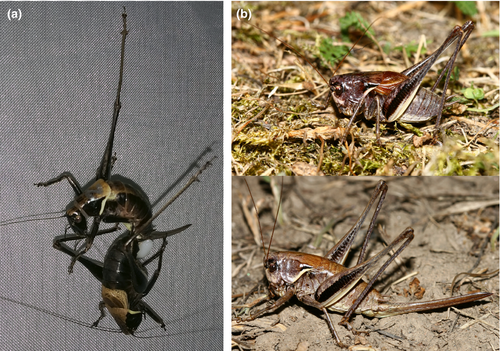 | Dorková, Martina; Krištín, Anton; Jarčuška, Benjamín; Kaňuch, Peter The mosaic distribution pattern of two sister bush-cricket species and the possible role of reproductive interference Journal Article Ecology and Evolution, 10 (5), pp. 2570-2578, 2020, ISSN: 2045-7758. @article{Dorková2020, title = {The mosaic distribution pattern of two sister bush-cricket species and the possible role of reproductive interference}, author = {Martina Dorková and Anton Krištín and Benjamín Jarčuška and Peter Kaňuch}, doi = {0.3390/f11030288}, issn = {2045-7758}, year = {2020}, date = {2020-02-08}, journal = {Ecology and Evolution}, volume = {10}, number = {5}, pages = {2570-2578}, abstract = {Reproductive interference can shape regional distribution patterns in closely related species, if prezygotic isolation barriers are weak. The study of such interaction could be more challenging in nuptial gift‐giving species due to the direct nutritional effects on both sexes of both species during copulation. We mapped the distribution of two sister bush‐cricket species, Pholidoptera aptera and Pholidoptera transsylvanica, at the northern margin of their overlapping ranges in Europe, and with a behavioral experiment, we tested the possibility of heterospecific mating. We found a very rare coexistence of species locally (0.5%, n = 391 sites) with mostly mutually exclusive distribution patterns, resulting in a mosaic pattern of sympatry, whereas they occupied the same climate niche in forest‐dominated mountain landscape. Over 14 days of a mating experiment with seven mixed groups of conspecifics and heterospecifics (n = 56 individuals in total), the number of received spermatophores per female was 3–6 in P. aptera and 1–7 in P. transsylvanica. In total, we found 8.1% of heterospecific copulations (n = 99 transferred spermatophores with genetic identification of the donor species), while we also confirmed successful transfer of heterospecific sperms into a female's reproductive system. Because bush‐cricket females also obtain required nutrition from a heterospecific spermatophylax what should increase their fitness and fecundity, we suggest that their flexibility to mate with heterospecifics is beneficial and drives reproductive interference. This may substantially limit the reproductive success of the less frequent species (P. transsylvanica), coupled with eventual detrimental effects from hybridization, and result in the competitive exclusion of that species from their areas of coexistence.}, keywords = {}, pubstate = {published}, tppubtype = {article} } Reproductive interference can shape regional distribution patterns in closely related species, if prezygotic isolation barriers are weak. The study of such interaction could be more challenging in nuptial gift‐giving species due to the direct nutritional effects on both sexes of both species during copulation. We mapped the distribution of two sister bush‐cricket species, Pholidoptera aptera and Pholidoptera transsylvanica, at the northern margin of their overlapping ranges in Europe, and with a behavioral experiment, we tested the possibility of heterospecific mating. We found a very rare coexistence of species locally (0.5%, n = 391 sites) with mostly mutually exclusive distribution patterns, resulting in a mosaic pattern of sympatry, whereas they occupied the same climate niche in forest‐dominated mountain landscape. Over 14 days of a mating experiment with seven mixed groups of conspecifics and heterospecifics (n = 56 individuals in total), the number of received spermatophores per female was 3–6 in P. aptera and 1–7 in P. transsylvanica. In total, we found 8.1% of heterospecific copulations (n = 99 transferred spermatophores with genetic identification of the donor species), while we also confirmed successful transfer of heterospecific sperms into a female's reproductive system. Because bush‐cricket females also obtain required nutrition from a heterospecific spermatophylax what should increase their fitness and fecundity, we suggest that their flexibility to mate with heterospecifics is beneficial and drives reproductive interference. This may substantially limit the reproductive success of the less frequent species (P. transsylvanica), coupled with eventual detrimental effects from hybridization, and result in the competitive exclusion of that species from their areas of coexistence. |
 | Krištín, Anton; Jarčuška, Benjamín; Kaňuch, Peter An annotated checklist of crickets, grasshoppers and their allies (Orthoptera) in Slovakia Journal Article Zootaxa, 4869 (2), pp. 207-241, 2020, ISSN: 1175-5334. @article{Krištín2020, title = {An annotated checklist of crickets, grasshoppers and their allies (Orthoptera) in Slovakia}, author = {Anton Krištín and Benjamín Jarčuška and Peter Kaňuch}, doi = {10.11646/zootaxa.4869.2.3}, issn = {1175-5334}, year = {2020}, date = {2020-01-01}, journal = {Zootaxa}, volume = {4869}, number = {2}, pages = {207-241}, abstract = {The first annotated checklist of ensiferan and caeliferan Orthoptera of Slovakia is presented. Altogether, we found 129 species (59 Ensifera, 70 Caelifera) in the fauna of Slovakia, based on a critical revision of museum collections, all records published since 1826 and our own unpublished data from mapping in 1994–2019 (~2000 sites located in 97.5% of the mapping grid cells). Forty-four species reach the limit of their distributional range within the country, and 31 have their northern limit there. Four species are endemic to Slovakia. In total, 11 species were erroneously reported from the country and are not included in this checklist. The relatively rich species spectrum reflects the diversity of habitats in an area of about 50 thousand km2 and elevations from 94 to 2,655 masl. We found 30 species exclusive for the Pannonian and 18 for the Alpine biogeographical region in the study area. We emphasize changes compared to previous species lists published in 1977 and 1999, when nine species were first recorded after 1999, and eight other species have been missing for more than 50 years. Distributional patterns, accompanied by site maps, are commented for 42 species. Taxonomic, nomenclatural and zoogeographical problems are discussed for a further 23 species. Based on the actual IUCN Red List criteria, we assessed all 129 species. The species were red-listed as follows: regional extinct (Celes variabilis), critically endangered (Isophya beybienkoi, I. costata, Poecilimon fussii, Pachytrachis gracilis, Saga pedo, Paracaloptenus caloptenoides, Acrotylus insubricus, Stenobothrus fischeri), endangered (Poecilimon intermedius, Gampsocleis glabra, Pholidoptera frivaldszkyi, Myrmeleotettix antennatus), vulnerable (nine species), near threatened (18) and data deficient (12). A brief account of the Orthoptera research history in Slovakia is outlined.}, keywords = {}, pubstate = {published}, tppubtype = {article} } The first annotated checklist of ensiferan and caeliferan Orthoptera of Slovakia is presented. Altogether, we found 129 species (59 Ensifera, 70 Caelifera) in the fauna of Slovakia, based on a critical revision of museum collections, all records published since 1826 and our own unpublished data from mapping in 1994–2019 (~2000 sites located in 97.5% of the mapping grid cells). Forty-four species reach the limit of their distributional range within the country, and 31 have their northern limit there. Four species are endemic to Slovakia. In total, 11 species were erroneously reported from the country and are not included in this checklist. The relatively rich species spectrum reflects the diversity of habitats in an area of about 50 thousand km2 and elevations from 94 to 2,655 masl. We found 30 species exclusive for the Pannonian and 18 for the Alpine biogeographical region in the study area. We emphasize changes compared to previous species lists published in 1977 and 1999, when nine species were first recorded after 1999, and eight other species have been missing for more than 50 years. Distributional patterns, accompanied by site maps, are commented for 42 species. Taxonomic, nomenclatural and zoogeographical problems are discussed for a further 23 species. Based on the actual IUCN Red List criteria, we assessed all 129 species. The species were red-listed as follows: regional extinct (Celes variabilis), critically endangered (Isophya beybienkoi, I. costata, Poecilimon fussii, Pachytrachis gracilis, Saga pedo, Paracaloptenus caloptenoides, Acrotylus insubricus, Stenobothrus fischeri), endangered (Poecilimon intermedius, Gampsocleis glabra, Pholidoptera frivaldszkyi, Myrmeleotettix antennatus), vulnerable (nine species), near threatened (18) and data deficient (12). A brief account of the Orthoptera research history in Slovakia is outlined. |
2019 |
|
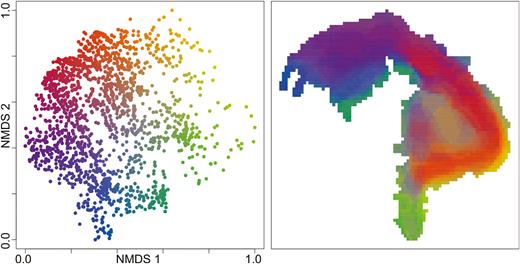 | Jarčuška, Benjamín; Kaňuch, Peter; Naďo, Ladislav; Krištín, Anton Quantitative biogeography of Orthoptera does not support classical qualitative regionalization of the Carpathian Mountains Journal Article Biological Journal of the Linnean Society : a journal of evolution, 128 (4), pp. 887-900, 2019, ISSN: 0024-4066. @article{Jarčuška2019, title = {Quantitative biogeography of Orthoptera does not support classical qualitative regionalization of the Carpathian Mountains}, author = {Benjamín Jarčuška and Peter Kaňuch and Ladislav Naďo and Anton Krištín}, doi = {10.1093/biolinnean/blz143}, issn = {0024-4066}, year = {2019}, date = {2019-10-11}, journal = {Biological Journal of the Linnean Society : a journal of evolution}, volume = {128}, number = {4}, pages = {887-900}, abstract = {The first biogeographical division of the Carpathians, the second largest mountain range in Europe, was based on qualitative observational floristic data > 100 years ago and has also been applied for the regional zoogeography. In this study, the recent availability of detailed quantitative data allowed us to perform a more powerful evaluation of the classical biogeographical regions of the area. Thus, we analysed updated distribution patterns of 137 Orthoptera species native to the Carpathian Mountains and, by using published species range maps, we compiled data on species presence or absence within 2576 cells of a 10 km × 10 km universal transverse mercator grid in the area. Pattern analysis of the data was based on non-metric multidimensional scaling and clustering using six different algorithms applied to a β sim dissimilarity matrix. The unweighted pair-group method using arithmetic averages, which gave the best performance in the analysis of species turnover, delineated four regions. Environmental variables and species richness were used in logistic regression as predictors of delineated clusters, and indicator species were identified for each of the inferred regions. The pattern can be explained, in part, by environmental variables and species richness (34.2%) and was also influenced by connections with the orthopterofauna from adjacent areas. The observed discrepancy between regionalization based on expert knowledge and the pattern revealed using quantitative data provides a warning that the biogeography of the Carpathians might also have been revised in other taxa, where only classical qualitative regionalization exists.}, keywords = {}, pubstate = {published}, tppubtype = {article} } The first biogeographical division of the Carpathians, the second largest mountain range in Europe, was based on qualitative observational floristic data > 100 years ago and has also been applied for the regional zoogeography. In this study, the recent availability of detailed quantitative data allowed us to perform a more powerful evaluation of the classical biogeographical regions of the area. Thus, we analysed updated distribution patterns of 137 Orthoptera species native to the Carpathian Mountains and, by using published species range maps, we compiled data on species presence or absence within 2576 cells of a 10 km × 10 km universal transverse mercator grid in the area. Pattern analysis of the data was based on non-metric multidimensional scaling and clustering using six different algorithms applied to a β sim dissimilarity matrix. The unweighted pair-group method using arithmetic averages, which gave the best performance in the analysis of species turnover, delineated four regions. Environmental variables and species richness were used in logistic regression as predictors of delineated clusters, and indicator species were identified for each of the inferred regions. The pattern can be explained, in part, by environmental variables and species richness (34.2%) and was also influenced by connections with the orthopterofauna from adjacent areas. The observed discrepancy between regionalization based on expert knowledge and the pattern revealed using quantitative data provides a warning that the biogeography of the Carpathians might also have been revised in other taxa, where only classical qualitative regionalization exists. |
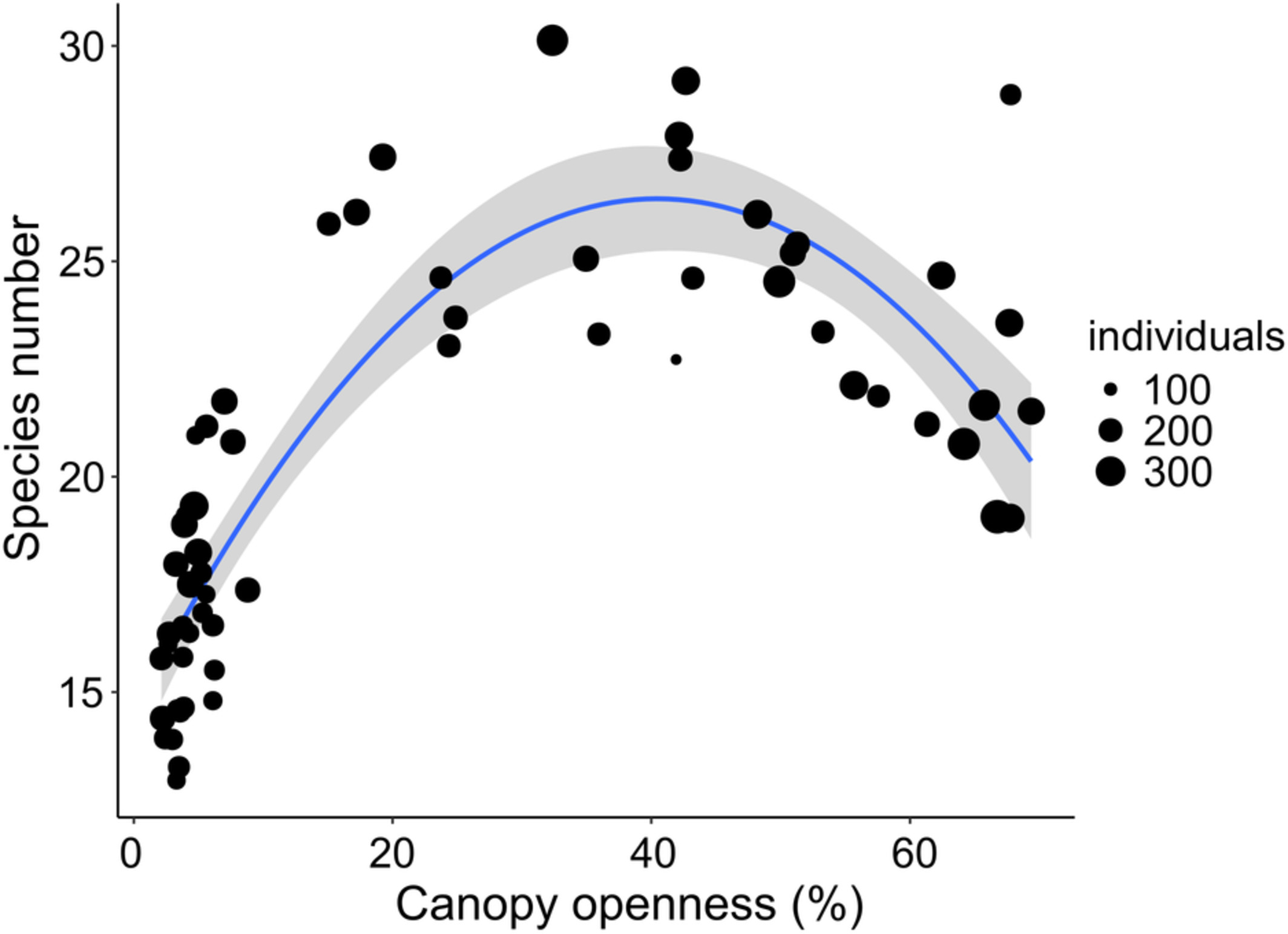 | Černecká, Ľudmila; Mihál, Ivan; Gajdoš, Peter; Jarčuška, Benjamín The effect of canopy openness of European beech (Fagus sylvatica) forests on ground‐dwelling spider communities Journal Article Insect Conservation and Diversity, 13 (3), pp. 250-261, 2019, ISSN: 1752-458X. @article{Černecká2019, title = {The effect of canopy openness of European beech (\textit{Fagus sylvatica}) forests on ground‐dwelling spider communities}, author = {Ľudmila Černecká and Ivan Mihál and Peter Gajdoš and Benjamín Jarčuška}, doi = {10.1111/icad.12380}, issn = {1752-458X}, year = {2019}, date = {2019-09-10}, journal = {Insect Conservation and Diversity}, volume = {13}, number = {3}, pages = {250-261}, keywords = {}, pubstate = {published}, tppubtype = {article} } |
Kehoe, Laura; Reis, Tiago; Virah-Sawmy, Malika; Balmford, Andrew; Kuemmerle, Tobias; Krištín, Anton; Jarčuška, Benjamín; Kanka, Róbert Make EU trade with Brazil sustainable Journal Article Science, 364 (6438), 2019, ISSN: 0036-8075. @article{Kehoe2019, title = {Make EU trade with Brazil sustainable}, author = {Laura Kehoe and Tiago Reis and Malika Virah-Sawmy and Andrew Balmford and Tobias Kuemmerle and Anton Krištín and Benjamín Jarčuška and Róbert Kanka}, doi = {10.1126/science.aaw8276}, issn = {0036-8075}, year = {2019}, date = {2019-04-26}, journal = {Science}, volume = {364}, number = {6438}, keywords = {}, pubstate = {published}, tppubtype = {article} } | |
 | Dorková, M; Naďo, L; Jarčuška, B; Kaňuch, P Size‐dependent mating pattern in a nuptial gift‐giving insect Journal Article Ecology and Evolution, 9 (1), pp. 454-462, 2019, ISSN: 2045-7758. @article{Dorková2019, title = {Size‐dependent mating pattern in a nuptial gift‐giving insect}, author = {M. Dorková and L. Naďo and B. Jarčuška and P. Kaňuch}, url = {http://ife.sk/wp-content/uploads/2016/10/ece3.4763.pdf}, doi = {10.1002/ece3.4763}, issn = {2045-7758}, year = {2019}, date = {2019-01-01}, journal = {Ecology and Evolution}, volume = {9}, number = {1}, pages = {454-462}, abstract = {The reproductive interests of females and males often diverge in terms of the number of mating partners, an individual’s phenotype, origin, genes, and parental investment. This conflict may lead to a variety of sex‐specific adaptations and also affect mate choice in both sexes. We conducted an experiment with the bush‐cricket Pholidoptera griseoaptera (Orthoptera, Tettigoniidae), a species in which females receive direct nutritional benefits during mating. Mated individuals could be assigned due to the genotype of male spermatodoses, which are stored in the female’s spermatheca. After 3 weeks of possible copulations in established mating groups which were random replications with four females and males we did not find consistent assortative mating preference regarding to body size of mates. However, our results showed that the frequency of within‐pair copulations (192 analyzed mating events in 128 possible pairwise combinations) was positively associated with the body size of both mated individuals with significant interaction between sexes (having one mate very large, association between body size and the number of copulations has weaken). Larger individuals also showed a higher degree of polygamy. This suggests that body size of this nuptial gift‐giving insect species is an important sexual trait according to which both sexes choose their optimal mating partner.}, keywords = {}, pubstate = {published}, tppubtype = {article} } The reproductive interests of females and males often diverge in terms of the number of mating partners, an individual’s phenotype, origin, genes, and parental investment. This conflict may lead to a variety of sex‐specific adaptations and also affect mate choice in both sexes. We conducted an experiment with the bush‐cricket Pholidoptera griseoaptera (Orthoptera, Tettigoniidae), a species in which females receive direct nutritional benefits during mating. Mated individuals could be assigned due to the genotype of male spermatodoses, which are stored in the female’s spermatheca. After 3 weeks of possible copulations in established mating groups which were random replications with four females and males we did not find consistent assortative mating preference regarding to body size of mates. However, our results showed that the frequency of within‐pair copulations (192 analyzed mating events in 128 possible pairwise combinations) was positively associated with the body size of both mated individuals with significant interaction between sexes (having one mate very large, association between body size and the number of copulations has weaken). Larger individuals also showed a higher degree of polygamy. This suggests that body size of this nuptial gift‐giving insect species is an important sexual trait according to which both sexes choose their optimal mating partner. |
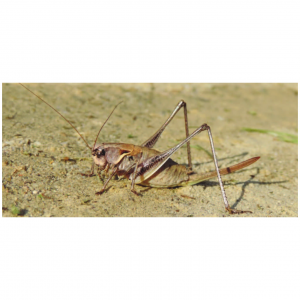 | Krištín, Anton; Jarčuška, Benjamín; Dorková, Martina; Kaňuch, Peter First record of Pholidoptera transsylvanica (Orthoptera, Tettigoniidae) in Poland Journal Article Entomological News, 128 (4), pp. 377, 2019. @article{Krištín2019, title = {First record of Pholidoptera transsylvanica (Orthoptera, Tettigoniidae) in Poland}, author = {Anton Krištín and Benjamín Jarčuška and Martina Dorková and Peter Kaňuch}, year = {2019}, date = {2019-01-01}, journal = {Entomological News}, volume = {128}, number = {4}, pages = {377}, keywords = {}, pubstate = {published}, tppubtype = {article} } |
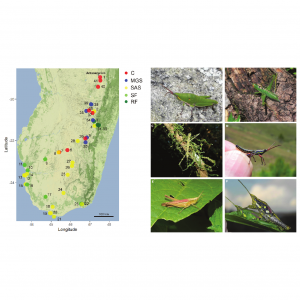 | Krištín, Anton; Heller, Klaus-Gerhard; Zemko, Milan; Rakotondranary, Jacques; Jarčuška, Benjamín Assemblages of orthopteroid insects along environmental gradients in central and southern Madagascar Journal Article Journal of Orthoptera Research, 28 (2), pp. 155-166, 2019. @article{Krištín2019b, title = {Assemblages of orthopteroid insects along environmental gradients in central and southern Madagascar}, author = {Anton Krištín and Klaus-Gerhard Heller and Milan Zemko and Jacques Rakotondranary and Benjamín Jarčuška}, year = {2019}, date = {2019-01-01}, journal = {Journal of Orthoptera Research}, volume = {28}, number = {2}, pages = {155-166}, keywords = {}, pubstate = {published}, tppubtype = {article} } |
Mojžiš, Marian; Jarčuška, Benjamín K hniezdnemu výskytu kôrovníka krátkoprstého (Certhia brachydactyla) v lesoch západnej časti Cerovej vrchoviny (južné Slovensko) Journal Article Tichodroma : ornitologický časopis, 31 , pp. 1-10, 2019, ISSN: 1337-026X. @article{Mojžiš2019, title = {K hniezdnemu výskytu kôrovníka krátkoprstého (\textit{Certhia brachydactyla}) v lesoch západnej časti Cerovej vrchoviny (južné Slovensko)}, author = {Marian Mojžiš and Benjamín Jarčuška}, issn = {1337-026X}, year = {2019}, date = {2019-01-01}, journal = {Tichodroma : ornitologický časopis}, volume = {31}, pages = {1-10}, keywords = {}, pubstate = {published}, tppubtype = {article} } | |
2018 |
|
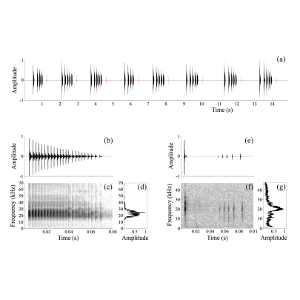 | Iorgu, I S; Krištín, A; Szövényi, G; Kaňuch, P; Jarčuška, B; Sahlean, T; Iorgu, E I; Orci, K M Bioacoustics , pp. 1-14, 2018. @article{IORGU2017, title = {Distinctive male–female acoustic duetting supports the specific status of \textit{Isophya fatrensis}, a West-Carpathian endemic bush-cricket (Insecta: Orthoptera: Tettigoniidae: Phaneropterinae)}, author = {I.S. Iorgu and A. Krištín and G. Szövényi and P. Kaňuch and B. Jarčuška and T. Sahlean and E.I. Iorgu and K.M. Orci}, url = {http://www.tandfonline.com/doi/abs/10.1080/09524622.2016.1272005?journalCode=tbio20}, doi = {DOI: 10.1080/09524622.2016.1272005 }, year = {2018}, date = {2018-02-01}, journal = {Bioacoustics }, pages = {1-14}, keywords = {}, pubstate = {published}, tppubtype = {article} } |
2017 |
|
 | Černecká, Ľudmila; Mihál, Ivan; Jarčuška, Benjamín Response of ground-dwelling harvestman assemblages (Arachnida: Opiliones) to European beech forest canopy cover Journal Article European Journal of Entomology, (114), pp. 334-342, 2017. @article{Černecká2017b, title = {Response of ground-dwelling harvestman assemblages (Arachnida: Opiliones) to European beech forest canopy cover}, author = {Ľudmila Černecká and Ivan Mihál and Benjamín Jarčuška}, url = {https://www.eje.cz/pdfs/eje/2017/01/42.pdf}, year = {2017}, date = {2017-07-24}, journal = {European Journal of Entomology}, number = {114}, pages = {334-342}, abstract = {We studied the effects of the overstory canopy cover on ground-dwelling harvestmen communities in European beech forests in the Western Carpathian Mts. We analyzed the differences in species richness, abundance and composition in two tree canopy cover categories (closed and open canopy). Overall, 1765 individuals belonging to 16 species were caught using pitfall traps. Repeated-measures ANOVA revealed that under both closed and open canopies a similar absolute and rarefi ed species richness and number of individuals (standardized to 100 pitfall trap days) were caught, and that both species richness and abundance were affected by the season (i.e., time of trap replacement); yet the total number of individuals trapped was more than two times greater under the open canopy than under the closed canopy. Despite the subtle differences in the taxonomic composition of the catches under the open and closed canopies revealed by DCA followed by RDA, the composition of ground dwelling harvestmen assemblages differed under the two canopy covers. The open canopy was more suitable for heliophilic, xerothermic eurytopic harvestmen species typical for open and ecotonal habitats, such as Egaenus convexus (C.L. Koch) and Oligolophus tridens (C.L. Koch) but still suitable for hemihygrophilic Lophopilio palpinalis (Herbst). The closed canopy stands were preferred by shade-tolerant, hygrophilic eurytopic harvestmen species, such as Trogulus sp. Latreille, Dicranolasma scabrum (Herbst) and Platybunus bucephalus (C.L. Koch). Our results highlight the importance of intra habitat heterogeneity of a harvestmen community.}, keywords = {}, pubstate = {published}, tppubtype = {article} } We studied the effects of the overstory canopy cover on ground-dwelling harvestmen communities in European beech forests in the Western Carpathian Mts. We analyzed the differences in species richness, abundance and composition in two tree canopy cover categories (closed and open canopy). Overall, 1765 individuals belonging to 16 species were caught using pitfall traps. Repeated-measures ANOVA revealed that under both closed and open canopies a similar absolute and rarefi ed species richness and number of individuals (standardized to 100 pitfall trap days) were caught, and that both species richness and abundance were affected by the season (i.e., time of trap replacement); yet the total number of individuals trapped was more than two times greater under the open canopy than under the closed canopy. Despite the subtle differences in the taxonomic composition of the catches under the open and closed canopies revealed by DCA followed by RDA, the composition of ground dwelling harvestmen assemblages differed under the two canopy covers. The open canopy was more suitable for heliophilic, xerothermic eurytopic harvestmen species typical for open and ecotonal habitats, such as Egaenus convexus (C.L. Koch) and Oligolophus tridens (C.L. Koch) but still suitable for hemihygrophilic Lophopilio palpinalis (Herbst). The closed canopy stands were preferred by shade-tolerant, hygrophilic eurytopic harvestmen species, such as Trogulus sp. Latreille, Dicranolasma scabrum (Herbst) and Platybunus bucephalus (C.L. Koch). Our results highlight the importance of intra habitat heterogeneity of a harvestmen community. |
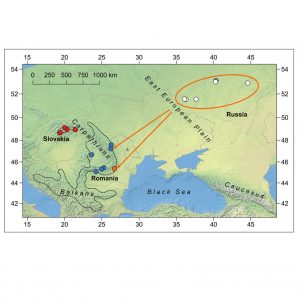 | Kaňuch, P; Dorková, M; Mikhailenko, A P; Polumordvinov, O A; Jarčuška, B; Krištín, A ZooKeys, 665 , pp. 85-92, 2017. @article{P.2017, title = {Isolated populations of the bush-cricket \textit{Pholidoptera frivaldszkyi} (Orthoptera, Tettigoniidae) in Russia suggest a disjunct area of the species distribution}, author = {P. Kaňuch and M. Dorková and A.P. Mikhailenko and O.A. Polumordvinov and B. Jarčuška and A. Krištín}, editor = {Z.F. Montealegre}, url = {https://zookeys.pensoft.net/article/12339/list/8/}, doi = {10.3897/zookeys.665.12339}, year = {2017}, date = {2017-04-04}, journal = {ZooKeys}, volume = {665}, pages = {85-92}, abstract = {Phylogenetic analysis and assessment of the species status of mostly isolated populations of Pholidoptera frivaldszkyi in south-western Russia occurring far beyond the accepted area of the species distribution in the Carpathian-Balkan region were performed. Using the mitochondrial DNA cytochrome c oxidase subunit I gene fragment, we found a very low level of genetic diversity in these populations. Phylogeographic reconstruction did not support recent introduction events but rather historical range fragmentation. The grouping of the Russian and Romanian haplotypes in a distinct phylogenetic clade suggests that the pre-glacial range of P. frivaldszkyi had extended towards the Ponto-Caspian region, with considerable gene flow between different refugia. However, post-glacial northward expansion of the species from supposed Caucasus refugia contributed most likely to the current disjunct distribution of this relict-like bush-cricket.}, keywords = {}, pubstate = {published}, tppubtype = {article} } Phylogenetic analysis and assessment of the species status of mostly isolated populations of Pholidoptera frivaldszkyi in south-western Russia occurring far beyond the accepted area of the species distribution in the Carpathian-Balkan region were performed. Using the mitochondrial DNA cytochrome c oxidase subunit I gene fragment, we found a very low level of genetic diversity in these populations. Phylogeographic reconstruction did not support recent introduction events but rather historical range fragmentation. The grouping of the Russian and Romanian haplotypes in a distinct phylogenetic clade suggests that the pre-glacial range of P. frivaldszkyi had extended towards the Ponto-Caspian region, with considerable gene flow between different refugia. However, post-glacial northward expansion of the species from supposed Caucasus refugia contributed most likely to the current disjunct distribution of this relict-like bush-cricket. |
2016 |
|
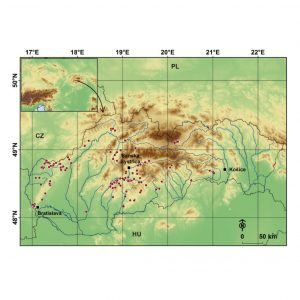 | Jarčuška, B; Slezák, M; Hrivnák, R; Senko, D Invasibility of alien Impatiens parviflora in temperate forest understories Journal Article Flora, 224 , pp. 14–23, 2016. @article{Jarčuška2016, title = {Invasibility of alien Impatiens parviflora in temperate forest understories}, author = {B. Jarčuška and M. Slezák and R. Hrivnák and D. Senko}, url = {http://www.sciencedirect.com/science/article/pii/S0367253016300937}, year = {2016}, date = {2016-12-31}, journal = {Flora}, volume = {224}, pages = {14–23}, abstract = {Closed-canopy forests had been assumed to be a highly resistant to plant invasions but recently it has been found that several invasive plants are also effectively adapted to shaded forest understories. One of them is small balsam, Impatiens parviflora, one of the most widespread invasive plants occurring in temperate and northern regions of Europe. Certain discrepancies in autecology of small balsam or in its interaction with native species in invaded communities have been published previously. These can be accounted for by habitat-related biases (e.g., restricted length of analysed environmental gradients), size of sampling units and geographical range of sampling. Therefore to achieve better insight into the success of small balsam, we used dataset of vegetation plots from various types of temperate forests in Western Carpathians, Slovakia. To identify principle environmental and vegetation-related determinants controlling cover values of small balsam in temperate forests, and to model small balsam’s response to particular gradients, we used Boosted Regression Trees (BRT), technique that can model complex curvilinear relationships and their interactions. While additive BRT-model accounted for 24.1% of variation in small balsam cover, model with up to five-way interactions explained 46.0%. Nutrients (Ellenberg indicator value) were the most influential predictor accounting for 21.6% of variance. We observed only weak negative association between herb-layer species richness and cover of small balsam. The highest cover of small balsam was observed at nutrient-richest sites, along with lowest summarised cover of other species in herb layer. Trade-offs between mean annual precipitation and nutrients were also observed for cover of small balsam; species cover was higher at nutrient-poorer sites that received lower mean annual precipitation, while opposite was true for nutrient rich sites. The present work is the first study showing the positive association between nutrients availability and small balsam cover in forest understories, at a large spatial scale.}, keywords = {}, pubstate = {published}, tppubtype = {article} } Closed-canopy forests had been assumed to be a highly resistant to plant invasions but recently it has been found that several invasive plants are also effectively adapted to shaded forest understories. One of them is small balsam, Impatiens parviflora, one of the most widespread invasive plants occurring in temperate and northern regions of Europe. Certain discrepancies in autecology of small balsam or in its interaction with native species in invaded communities have been published previously. These can be accounted for by habitat-related biases (e.g., restricted length of analysed environmental gradients), size of sampling units and geographical range of sampling. Therefore to achieve better insight into the success of small balsam, we used dataset of vegetation plots from various types of temperate forests in Western Carpathians, Slovakia. To identify principle environmental and vegetation-related determinants controlling cover values of small balsam in temperate forests, and to model small balsam’s response to particular gradients, we used Boosted Regression Trees (BRT), technique that can model complex curvilinear relationships and their interactions. While additive BRT-model accounted for 24.1% of variation in small balsam cover, model with up to five-way interactions explained 46.0%. Nutrients (Ellenberg indicator value) were the most influential predictor accounting for 21.6% of variance. We observed only weak negative association between herb-layer species richness and cover of small balsam. The highest cover of small balsam was observed at nutrient-richest sites, along with lowest summarised cover of other species in herb layer. Trade-offs between mean annual precipitation and nutrients were also observed for cover of small balsam; species cover was higher at nutrient-poorer sites that received lower mean annual precipitation, while opposite was true for nutrient rich sites. The present work is the first study showing the positive association between nutrients availability and small balsam cover in forest understories, at a large spatial scale. |
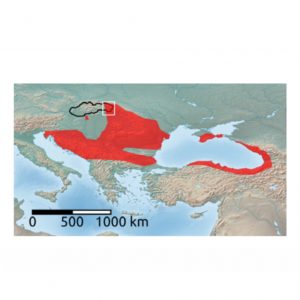 | Krištín, A; Jarčuška, B Distribution and ecology of the flightless bush-cricket Poecilimon schmidtii at its northern range margin Journal Article Biologia, 71 (9), pp. 1049-1060, 2016. @article{Krištín2016, title = {Distribution and ecology of the flightless bush-cricket Poecilimon schmidtii at its northern range margin}, author = {A. Krištín and B. Jarčuška}, url = {https://www.researchgate.net/publication/309281814_Distribution_and_ecology_of_the_flightless_bush-cricket_Poecilimon_schmidtii_at_its_northern_range_margin}, doi = {10.1515/biolog-2016-0128}, year = {2016}, date = {2016-09-01}, journal = {Biologia}, volume = {71}, number = {9}, pages = {1049-1060}, abstract = {The distributional patterns and ecology of the ponto-mediterranean species Poecilimon schmidtii were only insufficiently known until now, despite assumed to be one of the northernmost distributed species of the genus. Based on the review of all available published and own field data, we improved the distribution map of the species and recorded it for the first time from Poland. The distribution survey was carried at 1,208 sites in Slovakia, 39 sites in SE Poland and 26 sites in W Ukraine between 1994 and 2015. P. schmidtii was found at 59 sites and the habitat requirements were analysed. The results show a clear preference of the species for broadleaved forest ecotones with hazel and Rubus spp. shrubs being the main host plants. The species was present in grid cells with a lower mean altitude, a higher annual mean temperature and a lower annual precipitation compared to those available within the northern species’ range. Its altitudinal distribution was between 105 and 950 m a.s.l. Altogether, 70 Orthoptera and one mantid species were recorded and assemblages of Orthoptera and Mantodea were described for 49 sites with P. schmidtii in Slovakia and Poland. On average 18.9 ± 7.5 (SD) species were found per site, ranging from 7 to 37. Using detrended correspondence analysis it was not possible to distinguish between the orthopteran assemblages with and without (n = 94) P. schmidtii. In the assemblages, P. schmidtii was more often present with mountainous species. }, keywords = {}, pubstate = {published}, tppubtype = {article} } The distributional patterns and ecology of the ponto-mediterranean species Poecilimon schmidtii were only insufficiently known until now, despite assumed to be one of the northernmost distributed species of the genus. Based on the review of all available published and own field data, we improved the distribution map of the species and recorded it for the first time from Poland. The distribution survey was carried at 1,208 sites in Slovakia, 39 sites in SE Poland and 26 sites in W Ukraine between 1994 and 2015. P. schmidtii was found at 59 sites and the habitat requirements were analysed. The results show a clear preference of the species for broadleaved forest ecotones with hazel and Rubus spp. shrubs being the main host plants. The species was present in grid cells with a lower mean altitude, a higher annual mean temperature and a lower annual precipitation compared to those available within the northern species’ range. Its altitudinal distribution was between 105 and 950 m a.s.l. Altogether, 70 Orthoptera and one mantid species were recorded and assemblages of Orthoptera and Mantodea were described for 49 sites with P. schmidtii in Slovakia and Poland. On average 18.9 ± 7.5 (SD) species were found per site, ranging from 7 to 37. Using detrended correspondence analysis it was not possible to distinguish between the orthopteran assemblages with and without (n = 94) P. schmidtii. In the assemblages, P. schmidtii was more often present with mountainous species. |
2015 |
|
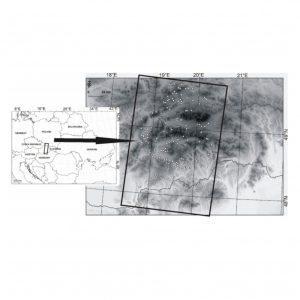 | Hrivnák, R; Slezák, M; Jarčuška, B; Jarolímek, I; Kochjarová, J Native and alien plant species richness response to soil nitrogen and phosphorus in temperate floodplain and swamp forests Journal Article Forests, 6 (10), pp. 3501-3513, 2015. @article{Hrivnák2015, title = {Native and alien plant species richness response to soil nitrogen and phosphorus in temperate floodplain and swamp forests}, author = {R. Hrivnák and M. Slezák and B. Jarčuška and I. Jarolímek and J. Kochjarová}, url = {http://www.mdpi.com/1999-4907/6/10/3501}, year = {2015}, date = {2015-10-07}, journal = {Forests}, volume = {6}, number = {10}, pages = {3501-3513}, abstract = {Soil nitrogen and phosphorus are commonly limiting elements affecting plant species richness in temperate zones. Our species richness-ecological study was performed in alder-dominated forests representing temperate floodplains (streamside alder forests of Alnion incanae alliance) and swamp forests (alder carrs of Alnion glutinosae alliance) in the Western Carpathians. Species richness (i.e., the number of vascular plants in a vegetation plot) was analyzed separately for native and alien vascular plants in 240 vegetation plots across the study area covering Slovakia, northern Hungary and southern Poland. The relationship between the species richness of each plant group and total soil nitrogen content, plant-available phosphorus and carbon to nitrogen (C/N) ratio was analyzed by generalized linear mixed models (GLMM) with Poisson error distribution and log-link function. The number of recorded native and alien species was 17–84 (average 45.4) and 0–9 (average 1.5) species per plot, respectively. The GLMMs were statistically significant (p ˂ 0.001) for both plant groups, but the total explained variation was higher for native (14%) than alien plants (9%). The richness of native species was negatively affected by the total soil nitrogen content and plant-available phosphorus, whereas the C/N ratio showed a positive impact. The alien richness was predicted only by the total soil nitrogen content showing a negative effect. }, keywords = {}, pubstate = {published}, tppubtype = {article} } Soil nitrogen and phosphorus are commonly limiting elements affecting plant species richness in temperate zones. Our species richness-ecological study was performed in alder-dominated forests representing temperate floodplains (streamside alder forests of Alnion incanae alliance) and swamp forests (alder carrs of Alnion glutinosae alliance) in the Western Carpathians. Species richness (i.e., the number of vascular plants in a vegetation plot) was analyzed separately for native and alien vascular plants in 240 vegetation plots across the study area covering Slovakia, northern Hungary and southern Poland. The relationship between the species richness of each plant group and total soil nitrogen content, plant-available phosphorus and carbon to nitrogen (C/N) ratio was analyzed by generalized linear mixed models (GLMM) with Poisson error distribution and log-link function. The number of recorded native and alien species was 17–84 (average 45.4) and 0–9 (average 1.5) species per plot, respectively. The GLMMs were statistically significant (p ˂ 0.001) for both plant groups, but the total explained variation was higher for native (14%) than alien plants (9%). The richness of native species was negatively affected by the total soil nitrogen content and plant-available phosphorus, whereas the C/N ratio showed a positive impact. The alien richness was predicted only by the total soil nitrogen content showing a negative effect. |
 | Kaňuch, P; Jarčuška, B; Kovács, L; Krištín, A Environmentally driven variability in size-selective females' mating frequency of bush-cricket Pholidoptera griseoaptera Journal Article Evolutionary Ecology, 29 (5), pp. 787–797, 2015. @article{Kaňuch2015, title = {Environmentally driven variability in size-selective females' mating frequency of bush-cricket \textit{Pholidoptera griseoaptera}}, author = {P. Kaňuch and B. Jarčuška and L. Kovács and A. Krištín}, url = {http://link.springer.com/article/10.1007/s10682-015-9784-5}, year = {2015}, date = {2015-07-28}, journal = {Evolutionary Ecology}, volume = {29}, number = {5}, pages = {787–797}, abstract = {Reproduction in less favourable conditions requires genetic adaptation and/or behavioural plasticity of the organism. In order to determine the effects of these mechanisms on environment-associated variability in polyandry, a phenomenon related to reproductive success, we explored the frequency of copulations in females of nuptial giftgiving bush-cricket Pholidoptera griseoaptera (Orthoptera: Tettigoniidae) using a laboratory experiment. In a factorial design, we reared two populations originating from contrasting altitudes in two temperature treatment conditions. After 3 weeks for possible copulations in established mating groups, females (n = 108) contained between 0 and 15 spermatodoses (a proxy for the number of copulations) in their spermatheca. The mean number of spermatodoses per female did not differ either between lowland and highland populations or between warm and cold treatments. Thus, we did not observe main effects of these two factors on adaptation or plasticity. In contrast, the frequency of copulations was significantly affected by female size as log(number of spermatodoses) increased by 0.41 ± 0.27 per each 0.1 mm of pronotum length. However, interactions between the body size (the trait that predicts females’ quality for reproduction) with environmental factors revealed that larger females originating from the highland population and larger females reared in cold treatment copulated more often than smaller ones, whereas females’ size did not affect copulation frequency in the lowland population or in warm treatment. It suggests stronger competition among females in harsher environmental conditions, whereas effect sizes of interaction terms showed that observed mating behaviour expressed a similar extent of genetic and plastic responses to female size. This first observation of environment-associated body size-dependent mating behaviour suggests the interplay of sexual and natural selection in a nuptial gift-giving species.}, keywords = {}, pubstate = {published}, tppubtype = {article} } Reproduction in less favourable conditions requires genetic adaptation and/or behavioural plasticity of the organism. In order to determine the effects of these mechanisms on environment-associated variability in polyandry, a phenomenon related to reproductive success, we explored the frequency of copulations in females of nuptial giftgiving bush-cricket Pholidoptera griseoaptera (Orthoptera: Tettigoniidae) using a laboratory experiment. In a factorial design, we reared two populations originating from contrasting altitudes in two temperature treatment conditions. After 3 weeks for possible copulations in established mating groups, females (n = 108) contained between 0 and 15 spermatodoses (a proxy for the number of copulations) in their spermatheca. The mean number of spermatodoses per female did not differ either between lowland and highland populations or between warm and cold treatments. Thus, we did not observe main effects of these two factors on adaptation or plasticity. In contrast, the frequency of copulations was significantly affected by female size as log(number of spermatodoses) increased by 0.41 ± 0.27 per each 0.1 mm of pronotum length. However, interactions between the body size (the trait that predicts females’ quality for reproduction) with environmental factors revealed that larger females originating from the highland population and larger females reared in cold treatment copulated more often than smaller ones, whereas females’ size did not affect copulation frequency in the lowland population or in warm treatment. It suggests stronger competition among females in harsher environmental conditions, whereas effect sizes of interaction terms showed that observed mating behaviour expressed a similar extent of genetic and plastic responses to female size. This first observation of environment-associated body size-dependent mating behaviour suggests the interplay of sexual and natural selection in a nuptial gift-giving species. |
2014 |
|
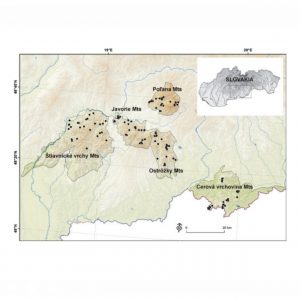 | Hrivnák, R; Gömöry, D; Slezák, M; Ujházy, K; Hédl, R; Jarčuška, B; Ujházyová, M Species richness pattern along altitudinal gradient in central European beech forests Journal Article Folia Geobotanica, 49 (3), pp. 425–441, 2014. @article{Hrivnák2014, title = {Species richness pattern along altitudinal gradient in central European beech forests}, author = {R. Hrivnák and D. Gömöry and M. Slezák and K. Ujházy and R. Hédl and B. Jarčuška and M. Ujházyová}, url = {http://link.springer.com/article/10.1007/s12224-013-9174-0}, doi = {10.1007/s12224-013-9174-0}, year = {2014}, date = {2014-09-01}, journal = {Folia Geobotanica}, volume = {49}, number = {3}, pages = {425–441}, abstract = {The unimodal species richness-altitude distribution pattern seems to be universal. To investigate the validity of this phenomenon in homogeneous substrate and vegetation conditions, we sampled beech-dominated forests in five volcanic mountain ranges in the Western Carpathians. European beech (Fagus sylvatica L.) formed monodominant closed-canopy stands at altitudes from 300 to 1,200 m. Along this gradient, the influence of beech on understory plant species richness was expected to be strong and uniform. The shape of the species richness-altitude relationship was analyzed for three datasets: herb layer, shrub layer, and both layers merged together. Contrary to prediction, the studied species richness-altitude relationship was inversely unimodal, with a minimum at intermediate altitudes. Quadratic regression models were statistically significant for all three datasets (P<0.001) and the explained variability ranged from 12 % to 20 %. The possible explanation for the observed pattern is twofold. In the central part of the altitudinal gradient, low species richness is due to strong competition by monodominant beech with accumulation of leaf litter and uptake soil resources, mainly water. This influence is somewhat released towards the margins of the gradient. Secondly, the species pool from the neighbouring communities increases species richness only in the lower parts of the altitudinal gradient.}, keywords = {}, pubstate = {published}, tppubtype = {article} } The unimodal species richness-altitude distribution pattern seems to be universal. To investigate the validity of this phenomenon in homogeneous substrate and vegetation conditions, we sampled beech-dominated forests in five volcanic mountain ranges in the Western Carpathians. European beech (Fagus sylvatica L.) formed monodominant closed-canopy stands at altitudes from 300 to 1,200 m. Along this gradient, the influence of beech on understory plant species richness was expected to be strong and uniform. The shape of the species richness-altitude relationship was analyzed for three datasets: herb layer, shrub layer, and both layers merged together. Contrary to prediction, the studied species richness-altitude relationship was inversely unimodal, with a minimum at intermediate altitudes. Quadratic regression models were statistically significant for all three datasets (P<0.001) and the explained variability ranged from 12 % to 20 %. The possible explanation for the observed pattern is twofold. In the central part of the altitudinal gradient, low species richness is due to strong competition by monodominant beech with accumulation of leaf litter and uptake soil resources, mainly water. This influence is somewhat released towards the margins of the gradient. Secondly, the species pool from the neighbouring communities increases species richness only in the lower parts of the altitudinal gradient. |
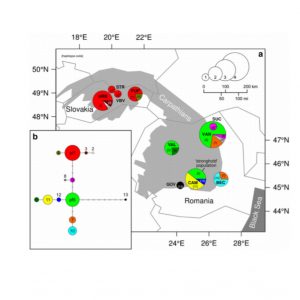 | Kaňuch, P; Jarčuška, B; Iorgu, E I; Iorgu, I S; Krištín, A Geographic variation in relict populations: genetics and phenotype of bush-cricket Pholidoptera frivaldskyi (Orthoptera) in Carpathians Journal Article Journal of Insect Conservation, 18 (2), pp. 257–266, 2014. @article{Kaňuch2014, title = {Geographic variation in relict populations: genetics and phenotype of bush-cricket \textit{Pholidoptera frivaldskyi} (Orthoptera) in Carpathians}, author = {P. Kaňuch and B. Jarčuška and E.I. Iorgu and I.S. Iorgu and A. Krištín}, url = {http://link.springer.com/article/10.1007/s10841-014-9636-6}, doi = {10.1007/s10841-014-9636-6}, year = {2014}, date = {2014-04-01}, journal = {Journal of Insect Conservation}, volume = {18}, number = {2}, pages = {257–266}, abstract = {A decreasing population size is often causing species extinction, however, relict species persisting in small-sized populations counter this. We analysed spatial genetic variation and past changes in population size at the maternally-inherited mitochondrial DNA level to clarify the origin of all recently known isolated populations of Pholidoptera frivaldskyi occurring in the range of Carpathian Mountains. Along with that we analysed also morphological variation as some phenotypic traits can retain useful information on population genetic structure. We found a relatively low genetic diversity within isolated populations as 778 bp COI gene sequences revealed only 13 unique haplotypes (n = 173 individuals from 10 populations). The spatial analysis of molecular variance identified three geographically homogenous genetic clusters (one in Slovakia and two in Romania) with a high level of differentiation among them, suggesting restricted gene flow, whilst Bayesian skyline simulation reconstructed a negative demographic change through evolutionary time. Inferred genetic pattern clearly coincides with differences in males’ colour phenotype as the extent of pigmentation on the lateral pronotum varied significantly among genetic lineages. We suggest that geographical variation in the species populations has relict-like character and their isolated occurrence is not a result of recent introduction events. Identification of ‘evolutionary units’ may help in the conservation and management of this rare insect species.}, keywords = {}, pubstate = {published}, tppubtype = {article} } A decreasing population size is often causing species extinction, however, relict species persisting in small-sized populations counter this. We analysed spatial genetic variation and past changes in population size at the maternally-inherited mitochondrial DNA level to clarify the origin of all recently known isolated populations of Pholidoptera frivaldskyi occurring in the range of Carpathian Mountains. Along with that we analysed also morphological variation as some phenotypic traits can retain useful information on population genetic structure. We found a relatively low genetic diversity within isolated populations as 778 bp COI gene sequences revealed only 13 unique haplotypes (n = 173 individuals from 10 populations). The spatial analysis of molecular variance identified three geographically homogenous genetic clusters (one in Slovakia and two in Romania) with a high level of differentiation among them, suggesting restricted gene flow, whilst Bayesian skyline simulation reconstructed a negative demographic change through evolutionary time. Inferred genetic pattern clearly coincides with differences in males’ colour phenotype as the extent of pigmentation on the lateral pronotum varied significantly among genetic lineages. We suggest that geographical variation in the species populations has relict-like character and their isolated occurrence is not a result of recent introduction events. Identification of ‘evolutionary units’ may help in the conservation and management of this rare insect species. |
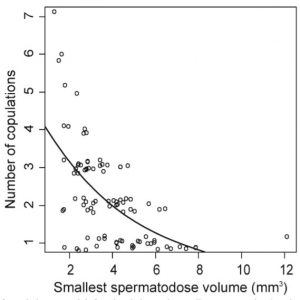 | Jarčuška, B; Kaňuch, P Female bush-crickets, Pholidoptera griseoaptera, that have received smaller ejaculates show a higher mating rate in the field Journal Article Journal of Insect Behavior, 27 (3), pp. 411–418, 2014. @article{Jarčuška2014, title = {Female bush-crickets, \textit{Pholidoptera griseoaptera}, that have received smaller ejaculates show a higher mating rate in the field}, author = {B. Jarčuška and P. Kaňuch}, url = {http://link.springer.com/article/10.1007/s10905-014-9438-4}, doi = {10.1007/s10905-014-9438-4}, year = {2014}, date = {2014-01-29}, journal = {Journal of Insect Behavior}, volume = {27}, number = {3}, pages = {411–418}, abstract = {Females of numerous insect species are known to be polyandrous, but there have been relatively few studies of factors associated with the degree of polyandry in females in the field. Number of copulations by females is negatively associated with ejaculate size across bush-cricket species. Assessing intraspecific variability is important when looking for and interpreting trait evolution. Therefore the aim of this study was to test the association between ejaculate size (i.e. volume of spermatodose–spermatophore-like structure formed within the spermatheca) and mating rate (i.e. number of spermatodoses) of females of Pholidoptera griseoaptera, while accounting for female body size (pronotum length) and age (number of hind leg’s cuticular bands). The results based on field-caught individuals suggested that there were statistically significant negative association between smallest and mean spermatodose volume, respectively, and number of copulations in this nuptial gift-giving bush-cricket species. This is in accordance with interspecific associations between ejaculate size and polyandry. However, lower slope of the intraspecific relationship may suggest lower importance of the ejaculate size in explaining females’ mating rate variability in this nuptial gift-giving species.}, keywords = {}, pubstate = {published}, tppubtype = {article} } Females of numerous insect species are known to be polyandrous, but there have been relatively few studies of factors associated with the degree of polyandry in females in the field. Number of copulations by females is negatively associated with ejaculate size across bush-cricket species. Assessing intraspecific variability is important when looking for and interpreting trait evolution. Therefore the aim of this study was to test the association between ejaculate size (i.e. volume of spermatodose–spermatophore-like structure formed within the spermatheca) and mating rate (i.e. number of spermatodoses) of females of Pholidoptera griseoaptera, while accounting for female body size (pronotum length) and age (number of hind leg’s cuticular bands). The results based on field-caught individuals suggested that there were statistically significant negative association between smallest and mean spermatodose volume, respectively, and number of copulations in this nuptial gift-giving bush-cricket species. This is in accordance with interspecific associations between ejaculate size and polyandry. However, lower slope of the intraspecific relationship may suggest lower importance of the ejaculate size in explaining females’ mating rate variability in this nuptial gift-giving species. |
2013 |
|
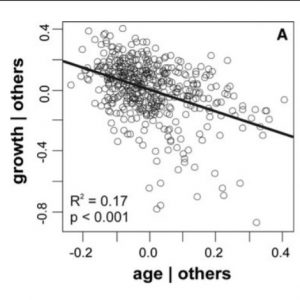 | Jarčuška, B; Day, M The effect of age on height growth in even-sized saplings of Fagus sylvatica L. Journal Article Trees, 27 (6), pp. 1821–1825, 2013. @article{Jarčuška2013, title = {The effect of age on height growth in even-sized saplings of \textit{Fagus sylvatica} L.}, author = {B. Jarčuška and M. Day}, url = {http://link.springer.com/article/10.1007/s00468-013-0911-z https://docs.google.com/file/d/0Bz8ojhHeiNclV01LSTJGS0Zmak0/edit}, doi = {10.1007/s00468-013-0911-z}, year = {2013}, date = {2013-07-30}, journal = {Trees}, volume = {27}, number = {6}, pages = {1821–1825}, abstract = {Common beech (Fagus sylvatica L.) saplings were studied along gradients of light availability (4–82 % of full sunlight), initial size (9–290 cm), and age (2–25 years) to examine the interactive effect of these variables on saplings’ annual height growth. Although age was non-significant as a main effect in a linear model, sapling age had a significant interaction with the other variables. After controlling for the effects of size and light, partial regression revealed that height growth was negatively affected by sapling age. Observed growth decline in older common-sized saplings may be explained not as effect of age per se, but as indirect age-related effect probably induced through plastic response of saplings to past growth conditions.}, keywords = {}, pubstate = {published}, tppubtype = {article} } Common beech (Fagus sylvatica L.) saplings were studied along gradients of light availability (4–82 % of full sunlight), initial size (9–290 cm), and age (2–25 years) to examine the interactive effect of these variables on saplings’ annual height growth. Although age was non-significant as a main effect in a linear model, sapling age had a significant interaction with the other variables. After controlling for the effects of size and light, partial regression revealed that height growth was negatively affected by sapling age. Observed growth decline in older common-sized saplings may be explained not as effect of age per se, but as indirect age-related effect probably induced through plastic response of saplings to past growth conditions. |
 | Jarčuška, B; Mihál, I; Cicák, A; Tsakov, H Beech bark necrosis: partitioning the environmental and spatial variation of the damage severity in Central and South-Eastern Europe Journal Article Annals of Forest Research, 56 , pp. 317-338, 2013. @article{Jarčuška2013b, title = {Beech bark necrosis: partitioning the environmental and spatial variation of the damage severity in Central and South-Eastern Europe}, author = {B. Jarčuška and I. Mihál and A. Cicák and H. Tsakov }, url = {http://www.afrjournal.org/index.php/afr/article/viewFile/34/53}, year = {2013}, date = {2013-01-01}, journal = {Annals of Forest Research}, volume = {56}, pages = {317-338}, abstract = { The beech bark necrosis (BBN) infestation severity of European beech (Fagus sylvatica L.) was assessed in regions of Central (CE) and South-Eastern Europe (SE). Altogether more than 10,000 trees were sampled at 114 sites. Using variation partitioning method, we examined the pure and shared effects of stand, site, climate and spatial sets of variables on mean BBN severity. Our rating included (i) the whole stand, (ii) tree social status classes, (iii) canopy (C) and (iv) understory (U) trees separately. We found that C trees were less affected by BBN than sub-canopy and U trees in both regions. There were found inter-regional differences in amount of explained variability (25.4–73.9%) for whole stand BBN and in the sensitivity of C and U trees to the environmental gradients. The analysis revealed that the climate and spatial variables followed by stand variables had the largest marginal effects on mean BBN severity in all models, while the site set of variables had the weakest one. More than half of the explained variation was shared among four sets of variables in SE, contrary to CE. Except to U trees in SE, the effect of climate – pure or spatially structured – remained the highest also after partitioning of variance; more in SE than in CE. Taking into account positive association between mean annual temperature and mean BBN severity in C trees in SE, reinforced negative effect of climate change on the necrosis might be expected to be more serious mainly in low situated beech forests there. Promoting the tree species diversity in areas with higher incidence of beech bark necrosis, i.e. in low altitudes in SE, could reduce the susceptibility of forests to the necrosis at regional level in the future. For better understanding of the relative importance of environmental and spatial variables on BBN severity, further research performed on finer spatial scale (extent and grain) is necessary, along with accounting for pathogens involved in the infestation.}, keywords = {}, pubstate = {published}, tppubtype = {article} } The beech bark necrosis (BBN) infestation severity of European beech (Fagus sylvatica L.) was assessed in regions of Central (CE) and South-Eastern Europe (SE). Altogether more than 10,000 trees were sampled at 114 sites. Using variation partitioning method, we examined the pure and shared effects of stand, site, climate and spatial sets of variables on mean BBN severity. Our rating included (i) the whole stand, (ii) tree social status classes, (iii) canopy (C) and (iv) understory (U) trees separately. We found that C trees were less affected by BBN than sub-canopy and U trees in both regions. There were found inter-regional differences in amount of explained variability (25.4–73.9%) for whole stand BBN and in the sensitivity of C and U trees to the environmental gradients. The analysis revealed that the climate and spatial variables followed by stand variables had the largest marginal effects on mean BBN severity in all models, while the site set of variables had the weakest one. More than half of the explained variation was shared among four sets of variables in SE, contrary to CE. Except to U trees in SE, the effect of climate – pure or spatially structured – remained the highest also after partitioning of variance; more in SE than in CE. Taking into account positive association between mean annual temperature and mean BBN severity in C trees in SE, reinforced negative effect of climate change on the necrosis might be expected to be more serious mainly in low situated beech forests there. Promoting the tree species diversity in areas with higher incidence of beech bark necrosis, i.e. in low altitudes in SE, could reduce the susceptibility of forests to the necrosis at regional level in the future. For better understanding of the relative importance of environmental and spatial variables on BBN severity, further research performed on finer spatial scale (extent and grain) is necessary, along with accounting for pathogens involved in the infestation. |
2012 |
|
 | Jarčuška, B; Milla, R Shoot level biomass allocation is affected by shoot type in Fagus sylvatica Journal Article Journal of Plant Ecology, 5 (4), pp. 422-428, 2012. @article{Jarčuška2012, title = {Shoot level biomass allocation is affected by shoot type in Fagus sylvatica}, author = {B. Jarčuška and R. Milla}, url = {https://oup.silverchair-cdn.com/oup/backfile/Content_public/Journal/jpe/5/4/10.1093_jpe_rts004/2/rts004.pdf?Expires=1498315012&Signature=gMJ91p2sieHzGVBiSjU2~lCvxOY5V~TRjfXM5E-6CGt7nB5RIm23HVwhZg7qqcOosG2CNliXlpM~-DDkDphE6O1bv5-xLKQk4PrOf4D7LkHXqEhtSpe4kH9B47cejKf3f4PzZBuFZn98XP20DEDioTOU50IOejoOcGYGCONBBAeUyYHDMg4snZfzN6IE~DSlWzCYISIYAFtCaJPbxaTk8yty6zhjUvyh~zM3WsfNlPihgzA52exTtyCGOqbj10r15oYdSL9WTOniPw-AXOrG~DZrjwaV6ArCw9hXbS5I-57vDzG98wbuDlAju88Mn8Sr9JWaBDOrxhOcXuYkEsf7-w__&Key-Pair-Id=APKAIUCZBIA4LVPAVW3Q https://drive.google.com/file/d/0Bz8ojhHeiNclMjEwZjJlMDUtYzc5YS00NGFjLWI1NWUtNzM0OWI2ZTZlMjgz/view}, year = {2012}, date = {2012-12-31}, journal = {Journal of Plant Ecology}, volume = {5}, number = {4}, pages = {422-428}, abstract = {Aims The present study aims (i) to examine if recently reported interspecific shoot-level biomass allocational trade-offs, i.e. isometric trade-offs between leaf mass (LM) and stem mass (SM) and between leaf size and leaf number, hold intraspecifically and (ii) to explore whether those scaling relationships are independent of shoot type (i.e. long vs. short shoots). Methods In order to address our questions, we used Fagus sylvatica saplings growing under a broad light range that were sampled in the Western Carpathians Mountains (Slovakia). Important Findings We found that: (i) intraspecific shoot-level biomass allocational trade-offs differ from those reported interspecifically and that (ii) long and short shoots differ in biomass allocation scaling coefficients. Allometric relationships with slopes statistically smaller than 1.0 or higher than −1.0, were found between SM and LM and between mean leafing intensity and individual leaf mass, respectively, in long shoots. In contrast, isometric scaling was found in short shoots. This suggests that leaf mass in short shoots is unaffected by shoot stem mass, in contrast to long shoots. Short shoots also had a larger fraction of biomass allocated to leaves. Beech shoots, as has been observed in other shoot dimorphic species, are specialized, with short shoots specializing in carbon gain and long shoots in space acquisition. A greater shift in LM than in SM among species during speciation shifting from allometric intraspecific relationships to an isometric interspecific scaling relationship between those traits could explain the discrepancies between the outputs of the present intraspecific study and others similar studies. This study draws attention to the importance of considering shoot types in future studies dealing with allocation rules in species with dimorphic shoots.}, keywords = {}, pubstate = {published}, tppubtype = {article} } Aims The present study aims (i) to examine if recently reported interspecific shoot-level biomass allocational trade-offs, i.e. isometric trade-offs between leaf mass (LM) and stem mass (SM) and between leaf size and leaf number, hold intraspecifically and (ii) to explore whether those scaling relationships are independent of shoot type (i.e. long vs. short shoots). Methods In order to address our questions, we used Fagus sylvatica saplings growing under a broad light range that were sampled in the Western Carpathians Mountains (Slovakia). Important Findings We found that: (i) intraspecific shoot-level biomass allocational trade-offs differ from those reported interspecifically and that (ii) long and short shoots differ in biomass allocation scaling coefficients. Allometric relationships with slopes statistically smaller than 1.0 or higher than −1.0, were found between SM and LM and between mean leafing intensity and individual leaf mass, respectively, in long shoots. In contrast, isometric scaling was found in short shoots. This suggests that leaf mass in short shoots is unaffected by shoot stem mass, in contrast to long shoots. Short shoots also had a larger fraction of biomass allocated to leaves. Beech shoots, as has been observed in other shoot dimorphic species, are specialized, with short shoots specializing in carbon gain and long shoots in space acquisition. A greater shift in LM than in SM among species during speciation shifting from allometric intraspecific relationships to an isometric interspecific scaling relationship between those traits could explain the discrepancies between the outputs of the present intraspecific study and others similar studies. This study draws attention to the importance of considering shoot types in future studies dealing with allocation rules in species with dimorphic shoots. |
 | Kaňuch, P; Jarčuška, B; Schlosserová, D; Sliacka, A; Paule, L; Krištín, A Landscape configuration determines gene flow and phenotype in a flightless forest-edge ground-dwelling bush-cricket, Pholidoptera griseoaptera Journal Article Evolutionary Ecology, 26 (6), pp. 1331–1343, 2012. @article{Kaňuch2012, title = {Landscape configuration determines gene flow and phenotype in a flightless forest-edge ground-dwelling bush-cricket, \textit{Pholidoptera griseoaptera}}, author = {P. Kaňuch and B. Jarčuška and D. Schlosserová and A. Sliacka and L. Paule and A. Krištín}, url = {http://link.springer.com/article/10.1007/s10682-012-9571-5 https://docs.google.com/file/d/0Bz8ojhHeiNclMno0bFprOTJrYVU/edit}, doi = {10.1007/s10682-012-9571-5}, year = {2012}, date = {2012-04-18}, journal = {Evolutionary Ecology}, volume = {26}, number = {6}, pages = {1331–1343}, abstract = {Spatial configuration of habitats influences genetic structure and population fitness whereas it affects mainly species with limited dispersal ability. To reveal how habitat fragmentation determines dispersal and dispersal-related morphology in a ground-dispersing insect species we used a bush-cricket (Pholidoptera griseoaptera) which is associated with forest-edge habitat. We analysed spatial genetic patterns together with variability of the phenotype in two forested landscapes with different levels of fragmentation. While spatial configuration of forest habitats did not negatively affect genetic characteristics related to the fitness of sampled populations, genetic differentiation was found higher among populations from an extensive forest. Compared to an agricultural matrix between forest patches, the matrix of extensive forest had lower permeability and posed barriers for the dispersal of this species. Landscape configuration significantly affected also morphological traits that are supposed to account for species dispersal potential; individuals from fragmented forest patches had longer hind femurs and a higher femur to pronotum ratio. This result suggests that selection pressure act differently on populations from both landscape types since dispersal-related morphology was related to the level of habitat fragmentation. Thus observed patterns may be explained as plastic according to the level of landscape configuration; while anthropogenic fragmentation of habitats for this species can lead to homogenization of spatial genetic structure.}, keywords = {}, pubstate = {published}, tppubtype = {article} } Spatial configuration of habitats influences genetic structure and population fitness whereas it affects mainly species with limited dispersal ability. To reveal how habitat fragmentation determines dispersal and dispersal-related morphology in a ground-dispersing insect species we used a bush-cricket (Pholidoptera griseoaptera) which is associated with forest-edge habitat. We analysed spatial genetic patterns together with variability of the phenotype in two forested landscapes with different levels of fragmentation. While spatial configuration of forest habitats did not negatively affect genetic characteristics related to the fitness of sampled populations, genetic differentiation was found higher among populations from an extensive forest. Compared to an agricultural matrix between forest patches, the matrix of extensive forest had lower permeability and posed barriers for the dispersal of this species. Landscape configuration significantly affected also morphological traits that are supposed to account for species dispersal potential; individuals from fragmented forest patches had longer hind femurs and a higher femur to pronotum ratio. This result suggests that selection pressure act differently on populations from both landscape types since dispersal-related morphology was related to the level of habitat fragmentation. Thus observed patterns may be explained as plastic according to the level of landscape configuration; while anthropogenic fragmentation of habitats for this species can lead to homogenization of spatial genetic structure. |
2011 |
|
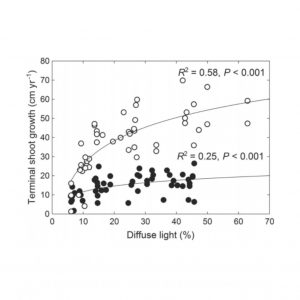 | Jarčuška, B Morphological plasticity of leaves in natural regeneration of Fagus sylvatica: effect of direct and diffuse light, ontogeny and shoot type Journal Article Polish Journal of Ecology, 59 , pp. 339–353, 2011. @article{Jarčuška2011, title = {Morphological plasticity of leaves in natural regeneration of Fagus sylvatica: effect of direct and diffuse light, ontogeny and shoot type}, author = {B. Jarčuška }, url = {https://drive.google.com/file/d/0Bz8ojhHeiNclZTM4NWQ3NmEtNTlmMS00MWRmLTkxMjMtNmZiNmQ4ZmU1ZWZl/view}, year = {2011}, date = {2011-12-31}, journal = {Polish Journal of Ecology}, volume = {59}, pages = {339–353}, abstract = {It is known that the role of accessible light as a growth-determining factor in beech natural regeneration rises in importance with growth of individuals. However, the accompanied changes in leaf traits underlying this shift in light demands are not well known. The aim of this study was to investigate influence of ontogenetic stage (0.5 m high ‘seedlings‘, 2.1 m ‘saplings‘), shoot type (terminal, lateral long and lateral short) and diffuse and direct light on morphological traits of leaves at spring-shoot-level in naturally regenerated beech individuals – shoot mean leaf area (mLA), shoot mean leaf weight (mLW), leaf mass per area (LMA), leaf area per shoot unit length (LAL), leaf mass per shoot unit length (LWL), number of leaves per shoot unit length (NLL), and ratio of mean-leaf width to its length (LSh). Ontogenetic drift affected the values of these traits; its influence depended on shoot type and component of light. The light explained more trait variability in saplings compared to seedlings (on average 45% vs 32%). The most evident shift was in the case of direct light – while direct light explained on average 18% of traits variability in seedlings, it was about 42% in saplings. The saplings compared with seedlings showed higher values of mLA, mLW, LMA, LAL on short shoots, LWL on lateral long and short shoots, LSh on terminal and lateral long shoots, and lower NLL values on terminal and long lateral shoots. Plastic response to light was higher in saplings than in seedlings (except mLA). Generally, the observed traits showed more plastic response to diffuse than to direct light in seedlings; the response of saplings was similar in both light components. The most plastic trait was LMA, the least LSh. Individuals of saplings displayed higher plasticity in traits close correlating with annual length growth of main axis, which suggests that saplings would benefit from increased light availability more than seedlings. }, keywords = {}, pubstate = {published}, tppubtype = {article} } It is known that the role of accessible light as a growth-determining factor in beech natural regeneration rises in importance with growth of individuals. However, the accompanied changes in leaf traits underlying this shift in light demands are not well known. The aim of this study was to investigate influence of ontogenetic stage (0.5 m high ‘seedlings‘, 2.1 m ‘saplings‘), shoot type (terminal, lateral long and lateral short) and diffuse and direct light on morphological traits of leaves at spring-shoot-level in naturally regenerated beech individuals – shoot mean leaf area (mLA), shoot mean leaf weight (mLW), leaf mass per area (LMA), leaf area per shoot unit length (LAL), leaf mass per shoot unit length (LWL), number of leaves per shoot unit length (NLL), and ratio of mean-leaf width to its length (LSh). Ontogenetic drift affected the values of these traits; its influence depended on shoot type and component of light. The light explained more trait variability in saplings compared to seedlings (on average 45% vs 32%). The most evident shift was in the case of direct light – while direct light explained on average 18% of traits variability in seedlings, it was about 42% in saplings. The saplings compared with seedlings showed higher values of mLA, mLW, LMA, LAL on short shoots, LWL on lateral long and short shoots, LSh on terminal and lateral long shoots, and lower NLL values on terminal and long lateral shoots. Plastic response to light was higher in saplings than in seedlings (except mLA). Generally, the observed traits showed more plastic response to diffuse than to direct light in seedlings; the response of saplings was similar in both light components. The most plastic trait was LMA, the least LSh. Individuals of saplings displayed higher plasticity in traits close correlating with annual length growth of main axis, which suggests that saplings would benefit from increased light availability more than seedlings. |
![Prirodzená obnova buka [Natural regeneration of beech]](https://ife.sk/wp-content/uploads/2016/10/2011_jarcuska-300x300.jpg) | Barna, M; Jarčuška, B Prirodzená obnova buka [Natural regeneration of beech] Book Chapter Barna, M; Kulfan, J; Bublinec, E (Ed.): Buk a bukové ekosystémy Slovenska, Chapter 11, pp. 227-248, Veda, Bratislava, 2011. @inbook{Barna2011, title = {Prirodzená obnova buka [Natural regeneration of beech]}, author = {M. Barna and B. Jarčuška }, editor = {M. Barna and J. Kulfan and E. Bublinec }, url = {https://drive.google.com/file/d/0Bz8ojhHeiNclNWYwNzY4ZGMtYzQwYi00OGI2LThhNjQtMTU3NzA4NTc2OTQ3/view}, year = {2011}, date = {2011-01-01}, booktitle = {Buk a bukové ekosystémy Slovenska}, pages = {227-248}, publisher = {Veda}, address = {Bratislava}, chapter = {11}, keywords = {}, pubstate = {published}, tppubtype = {inbook} } |
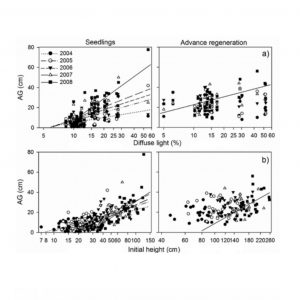 | Jarčuška, B; Barna, M Influence of light availability on height growth of naturally regenerated beech with different growth histories Journal Article Austrian Journal of Forest Science, 128 , pp. 53-65, 2011. @article{Jarčuška2011, title = { Influence of light availability on height growth of naturally regenerated beech with different growth histories}, author = {B. Jarčuška and M. Barna}, url = {https://drive.google.com/file/d/0Bz8ojhHeiNclNmEwNTkwODEtM2NjNC00Yzk3LTgwZDEtNTczYTQ3Y2ViZTZh/view}, year = {2011}, date = {2011-01-01}, journal = {Austrian Journal of Forest Science}, volume = {128}, pages = {53-65}, abstract = {We studied the influence of diffuse light supply on height growth dynamics in European beech natural regeneration. We evaluated the annual growth of the main axis over 5 yrs in 7-yr-old seedlings germinated 1 yr after a canopy release, and in 12-yr-old individuals of advance regeneration germinated 5 yrs before the release. In the advance regeneration, a significant response of annual growth to diffuse light was recorded six years after the canopy release. The correlation between the initial height and annual shoot growth in the seedlings over the study period was high (R2 ranged between Seite 54 Benjamín Jarcuška and Milan Barna 0.38 – 0.58); on the other hand, in the advance regeneration, significant correlation was not observed until the 7-th year after the overstory canopy release. We discuss the possible causes underlying the delay of height growth response to the current – modified light conditions in the advance regeneration.}, keywords = {}, pubstate = {published}, tppubtype = {article} } We studied the influence of diffuse light supply on height growth dynamics in European beech natural regeneration. We evaluated the annual growth of the main axis over 5 yrs in 7-yr-old seedlings germinated 1 yr after a canopy release, and in 12-yr-old individuals of advance regeneration germinated 5 yrs before the release. In the advance regeneration, a significant response of annual growth to diffuse light was recorded six years after the canopy release. The correlation between the initial height and annual shoot growth in the seedlings over the study period was high (R2 ranged between Seite 54 Benjamín Jarcuška and Milan Barna 0.38 – 0.58); on the other hand, in the advance regeneration, significant correlation was not observed until the 7-th year after the overstory canopy release. We discuss the possible causes underlying the delay of height growth response to the current – modified light conditions in the advance regeneration. |
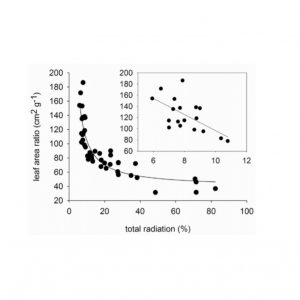 | Jarčuška, B; Barna, M Plasticity in above-ground biomass allocation in Fagus sylvatica L. saplings in response to light availability Journal Article Annals of Forest Research, 54 , pp. 151-160, 2011. @article{Jarčuška2011c, title = {Plasticity in above-ground biomass allocation in Fagus sylvatica L. saplings in response to light availability}, author = {B. Jarčuška and M. Barna }, url = {http://www.editurasilvica.ro/afr/54/2/jarcuska.pdf}, year = {2011}, date = {2011-01-01}, journal = {Annals of Forest Research}, volume = {54}, pages = {151-160}, abstract = {The paper presents the production and allocation of aboveground biomass in 7-yr-old saplings of European beech (Fagus sylvatica L.) growing along an environmental gradient with a total light transmittance (Tot) ranging from 6% to 80%. Non-overtopped individuals, not suppressed by surrounding saplings were sampled at the end of growing season. The total aboveground biomass production on the gradient varied within 1.7-261.0. Light in the log-log linear relationship accounted for 83% of this variability. The plants growing in the shade had lower mass of aboveground compartments, lower total leaf area, higher fraction of biomass allocated in foliar mass and lower in the in the woody mass compared to the plants growing in the high-light environment. The major changes in effects of light availability on biomass allocation occurred up to about 20% of Tot. Decreasing accessible light was responsible for a non-linear increase in interceptive leaf area per unit of biomass and decrease in amount of biomass allocated per a unit of branch and stem length – necessary for leaf display. There was a close correlation between mass of aboveground plant compartments, documented by Pearson’s r values of 0.98-0.99. Accompanied with different plant size, observed differences in biomass partitioning in response to light could be viewed as plastic adjustment to environmental heterogeneity in even-aged European beech saplings.}, keywords = {}, pubstate = {published}, tppubtype = {article} } The paper presents the production and allocation of aboveground biomass in 7-yr-old saplings of European beech (Fagus sylvatica L.) growing along an environmental gradient with a total light transmittance (Tot) ranging from 6% to 80%. Non-overtopped individuals, not suppressed by surrounding saplings were sampled at the end of growing season. The total aboveground biomass production on the gradient varied within 1.7-261.0. Light in the log-log linear relationship accounted for 83% of this variability. The plants growing in the shade had lower mass of aboveground compartments, lower total leaf area, higher fraction of biomass allocated in foliar mass and lower in the in the woody mass compared to the plants growing in the high-light environment. The major changes in effects of light availability on biomass allocation occurred up to about 20% of Tot. Decreasing accessible light was responsible for a non-linear increase in interceptive leaf area per unit of biomass and decrease in amount of biomass allocated per a unit of branch and stem length – necessary for leaf display. There was a close correlation between mass of aboveground plant compartments, documented by Pearson’s r values of 0.98-0.99. Accompanied with different plant size, observed differences in biomass partitioning in response to light could be viewed as plastic adjustment to environmental heterogeneity in even-aged European beech saplings. |
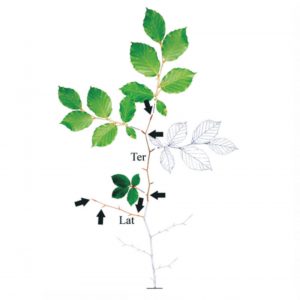 | Jarčuška, B Is preformation of future shoots in Fagus sylvatica L. buds reflected in bud/sprouted shoot traits relationships? Journal Article Dendrobiology, 66 , pp. 25-31, 2011. @article{Jarčuška2011c, title = {Is preformation of future shoots in Fagus sylvatica L. buds reflected in bud/sprouted shoot traits relationships?}, author = {B. Jarčuška}, url = {https://drive.google.com/file/d/0Bz8ojhHeiNclZWIyZjhmYjUtYzlmNi00ZTAxLTliYjQtM2M3ZGQ1NGI1MGY1/view}, year = {2011}, date = {2011-01-01}, journal = {Dendrobiology}, volume = {66}, pages = {25-31}, abstract = {The present study was aimed to find out whether the preformation of future shoot’s organs within a bud is reflected in the bud size/shoot functional traits’ size relationships. The survey attempts to evaluate whether relationships between the bud mass and stem mass, leaf mass, leaf area, total mass and number of leaves, respectively, of spring-shoot sprouted by the bud in Fagus sylvatica (L.) saplings are affected by parental bud location within shoot and parental shoot type. Dry mass of the terminal bud, the first and the last lateral buds placed on terminal and uppermost lateral shoots was estimated nondestructively for 58 beech saplings in December 2008. The shoots sprouted from the measured buds were sampled at the end of growing season, in August 2009. Bud mass, parental shoot type and bud location explained about 90% of shoot traits variability in full-factorial ANOVA. The leaf mass was the only shoot trait not affected by parental shoot type and bud location within shoot in scaling relationship with bud mass. There was not found differences among intercepts across parental shoot types and bud locations, however significant shift along common slope was observed among them. The presented findings could be viewed as a confirmation of the preformation and full development of leaf primordia within the European beech buds prior to bud burst. }, keywords = {}, pubstate = {published}, tppubtype = {article} } The present study was aimed to find out whether the preformation of future shoot’s organs within a bud is reflected in the bud size/shoot functional traits’ size relationships. The survey attempts to evaluate whether relationships between the bud mass and stem mass, leaf mass, leaf area, total mass and number of leaves, respectively, of spring-shoot sprouted by the bud in Fagus sylvatica (L.) saplings are affected by parental bud location within shoot and parental shoot type. Dry mass of the terminal bud, the first and the last lateral buds placed on terminal and uppermost lateral shoots was estimated nondestructively for 58 beech saplings in December 2008. The shoots sprouted from the measured buds were sampled at the end of growing season, in August 2009. Bud mass, parental shoot type and bud location explained about 90% of shoot traits variability in full-factorial ANOVA. The leaf mass was the only shoot trait not affected by parental shoot type and bud location within shoot in scaling relationship with bud mass. There was not found differences among intercepts across parental shoot types and bud locations, however significant shift along common slope was observed among them. The presented findings could be viewed as a confirmation of the preformation and full development of leaf primordia within the European beech buds prior to bud burst. |
2010 |
|
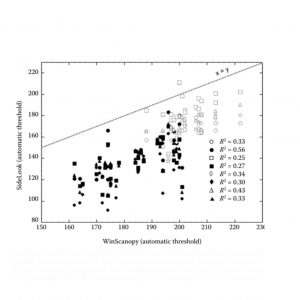 | Jarčuška, B; Kucbel, S; Jaloviar, P Comparison of output results from two programmes for hemispherical image analysis: Gap Light Analyser and WinScanopy Journal Article Journal of Forest Science, 56 , pp. 147–153, 2010. @article{Jarčuška2010, title = {Comparison of output results from two programmes for hemispherical image analysis: Gap Light Analyser and WinScanopy}, author = {B. Jarčuška and S. Kucbel and P. Jaloviar}, url = {https://drive.google.com/file/d/0Bz8ojhHeiNclcVZaa0xlSFFTbUtVeDhhT3dYR0M0QQ/view}, year = {2010}, date = {2010-01-01}, journal = {Journal of Forest Science}, volume = {56}, pages = {147–153}, abstract = {We compare the results of the analysis of hemispherical images (of a broadleaved and a coniferous forest) obtained using the Gap Light Analyser (GLA) software and the results obtained by analyzing the same images with the aid of WinScanopy. The two packages were used to calculate relative total, relative diffuse and relative direct transmittance, canopy openness, and leaf area index. Our aim was to find out whether it is possible to compare the studies using different software packages for determining light conditions. The binary pixel classification of images of canopy and sky was performed automatically (in the case of Gap Light Analyser, using the SideLook programme). The threshold values determined by the SideLook programme were lower compared to the WinScanopy, which was also reflected in the evaluated output results. There was a strong positive correlation between the results obtained with the two software packages (R2 ranges from 0.814 to 0.999). However, when the Gap Light Analyser analysis was applied to the threshold values obtained with the SideLook, the output results mostly manifested systematic differences in comparison with the output results obtained using the WinScanopy. Using the same threshold value in both programmes, the differences between the output values were quite small (a minimum of 0.038 m2.m–2 for LAI in the spruce forest and a maximum of 0.738% for total relative transmittance also in the spruce forest). The differences in some characteristics were statistically significant, on the other hand, both the photo series had only the identical direct transmittance values. The observed differences can be explained by differences in the calibration of the used camera-lens pair, different image registration techniques and different theoretical background and models used in the two software packages. It follows that it is also necessary to be aware of possible differences when comparing the outputs of the two compared software packages analyzing photos obtained applying the same methodical approach.}, keywords = {}, pubstate = {published}, tppubtype = {article} } We compare the results of the analysis of hemispherical images (of a broadleaved and a coniferous forest) obtained using the Gap Light Analyser (GLA) software and the results obtained by analyzing the same images with the aid of WinScanopy. The two packages were used to calculate relative total, relative diffuse and relative direct transmittance, canopy openness, and leaf area index. Our aim was to find out whether it is possible to compare the studies using different software packages for determining light conditions. The binary pixel classification of images of canopy and sky was performed automatically (in the case of Gap Light Analyser, using the SideLook programme). The threshold values determined by the SideLook programme were lower compared to the WinScanopy, which was also reflected in the evaluated output results. There was a strong positive correlation between the results obtained with the two software packages (R2 ranges from 0.814 to 0.999). However, when the Gap Light Analyser analysis was applied to the threshold values obtained with the SideLook, the output results mostly manifested systematic differences in comparison with the output results obtained using the WinScanopy. Using the same threshold value in both programmes, the differences between the output values were quite small (a minimum of 0.038 m2.m–2 for LAI in the spruce forest and a maximum of 0.738% for total relative transmittance also in the spruce forest). The differences in some characteristics were statistically significant, on the other hand, both the photo series had only the identical direct transmittance values. The observed differences can be explained by differences in the calibration of the used camera-lens pair, different image registration techniques and different theoretical background and models used in the two software packages. It follows that it is also necessary to be aware of possible differences when comparing the outputs of the two compared software packages analyzing photos obtained applying the same methodical approach. |
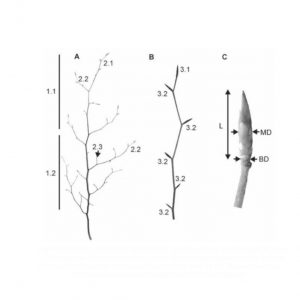 | Jarčuška, B Allometry of winter buds in beech (Fagus sylvatica L.) natural regeneration with respect to its volume and dry weight estimation. Journal Article Folia Oecologica, 37 (1), pp. 42-50, 2010. @article{Jarčuška2010b, title = {Allometry of winter buds in beech (Fagus sylvatica L.) natural regeneration with respect to its volume and dry weight estimation. }, author = {B Jarčuška}, url = {http://ife.sk/wp-content/uploads/2016/10/FO_37_1_jarčuska.pdf}, year = {2010}, date = {2010-01-01}, journal = {Folia Oecologica}, volume = {37}, number = {1}, pages = {42-50}, abstract = {Allometric relationships among bud’s fresh volume (V), length (L), maximal diameter (MD), basal diameter (BD), and dry weight (W) in beech (Fagus sylvatica L.) saplings manifest strong mutual correlations. These correlations depend on the bud type determined by bud position on shoot, shoot type and shoot position in crown. However, in most cases the differences among the bud types are not distinct – individual types can be classified into several overlapping groups. The bud type significantly influences bud shape characterised by the ratios of BD to MD, and BD to L; on the other hand, it has no influence on MD/L and bud density (V/W). Influence of accessible light on bud shape and density also depends on bud type. For non-destructive estimation of V and W, we have prepared a regression model using as independent variable the volume of cylinder enclosing the bud (Vcyl). This model could explain 98% of the variation in V and W, with a relative accuracy of 6.4% for V, and 5.4% for W (P = 0.95). The performance of the model was verified by a test allowing us to conclude that the model outputs are comparable with directly measured values.}, keywords = {}, pubstate = {published}, tppubtype = {article} } Allometric relationships among bud’s fresh volume (V), length (L), maximal diameter (MD), basal diameter (BD), and dry weight (W) in beech (Fagus sylvatica L.) saplings manifest strong mutual correlations. These correlations depend on the bud type determined by bud position on shoot, shoot type and shoot position in crown. However, in most cases the differences among the bud types are not distinct – individual types can be classified into several overlapping groups. The bud type significantly influences bud shape characterised by the ratios of BD to MD, and BD to L; on the other hand, it has no influence on MD/L and bud density (V/W). Influence of accessible light on bud shape and density also depends on bud type. For non-destructive estimation of V and W, we have prepared a regression model using as independent variable the volume of cylinder enclosing the bud (Vcyl). This model could explain 98% of the variation in V and W, with a relative accuracy of 6.4% for V, and 5.4% for W (P = 0.95). The performance of the model was verified by a test allowing us to conclude that the model outputs are comparable with directly measured values. |
2009 |
|
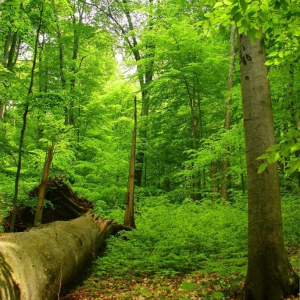 | Jarčuška, B Growth, survival, density, biomass partitioning and morphological adaptations of natural regeneration in Fagus sylvatica. A review Journal Article Dendrobiology, 61 , pp. 3-11, 2009. @article{Jarčuška2009, title = {Growth, survival, density, biomass partitioning and morphological adaptations of natural regeneration in Fagus sylvatica. A review}, author = {B. Jarčuška}, url = {http://www.idpan.poznan.pl/images/stories/dendrobiology/vol61/61_03_11.pdf}, year = {2009}, date = {2009-01-01}, journal = {Dendrobiology}, volume = {61}, pages = {3-11}, abstract = {Beech is an important woody species in terms of ecology, and it also has a considerable commercial value. This fact is also reflectedin a high number of scientific papers handling the issue of natural regeneration of this woody plant. The aim of this review is to analyse influence of resources availability and impact of other factors (competition) on height and diameter growth, survival, density, biomass partitioning and morphological adjustment in naturally regenerated beech seedlings and saplings. It pays a particular attention to light – the factor that influences, directly or indirectly, other environmental factors, and consequently, has the key influence on the performance of beech natural regeneration. This contribution includes information about e.g. shade tolerance and mortality-light relationships, ability to increase growth under improved light conditions, dependence of trees growth on their individual size and age etc. In spite of a large number of papers handling the issue of research on beech natural regeneration, growth responses in individual plants are difficult to predict, because the factors involved are numerous. Thus, the process of natural regeneration is in fact interactive, and even retroactive: any change in one of the involved factors induces adjustments of the others. }, keywords = {}, pubstate = {published}, tppubtype = {article} } Beech is an important woody species in terms of ecology, and it also has a considerable commercial value. This fact is also reflectedin a high number of scientific papers handling the issue of natural regeneration of this woody plant. The aim of this review is to analyse influence of resources availability and impact of other factors (competition) on height and diameter growth, survival, density, biomass partitioning and morphological adjustment in naturally regenerated beech seedlings and saplings. It pays a particular attention to light – the factor that influences, directly or indirectly, other environmental factors, and consequently, has the key influence on the performance of beech natural regeneration. This contribution includes information about e.g. shade tolerance and mortality-light relationships, ability to increase growth under improved light conditions, dependence of trees growth on their individual size and age etc. In spite of a large number of papers handling the issue of research on beech natural regeneration, growth responses in individual plants are difficult to predict, because the factors involved are numerous. Thus, the process of natural regeneration is in fact interactive, and even retroactive: any change in one of the involved factors induces adjustments of the others. |
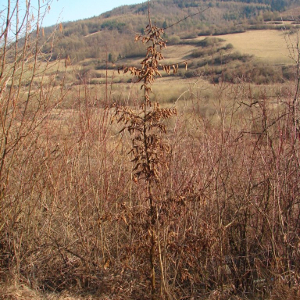 | Jarčuška, B Zaujímavé dendrologické nálezy z východnej časti Levočských vrchov a západnej časti Bachurne. Journal Article Natura Carpatica, 50 , pp. 121-124, 2009. @article{Jarčuška2009b, title = {Zaujímavé dendrologické nálezy z východnej časti Levočských vrchov a západnej časti Bachurne.}, author = {B. Jarčuška}, url = {https://drive.google.com/file/d/0Bz8ojhHeiNclMjQ5YTcyYzItMDA2NC00M2Y3LTk2MjYtM2YzMzU0ZTc0M2Qy/view?ddrp=1&hl=en#}, year = {2009}, date = {2009-01-01}, journal = {Natura Carpatica}, volume = {50}, pages = {121-124}, abstract = {With this contribution we confirm occurrence of the species Alnus glutinosa, Acer campestre, Carpinus betulus in eastern parts of the Levocske vrchy Mts and Sorbus aria in western part of the Bachuren Mts (valley of the Torysa River). The presence of these speciesin this area has not been documented yet. We also report a new locality (the second known) with Pinus mugo in the Levocske vrchy Mts - the most eastern locality with natural occurrence of this woody plant in Slovakia.}, keywords = {}, pubstate = {published}, tppubtype = {article} } With this contribution we confirm occurrence of the species Alnus glutinosa, Acer campestre, Carpinus betulus in eastern parts of the Levocske vrchy Mts and Sorbus aria in western part of the Bachuren Mts (valley of the Torysa River). The presence of these speciesin this area has not been documented yet. We also report a new locality (the second known) with Pinus mugo in the Levocske vrchy Mts - the most eastern locality with natural occurrence of this woody plant in Slovakia. |
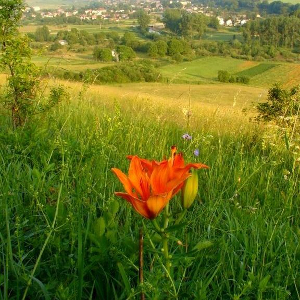 | Jarčuška, B Ľalia cibuľkonosná pravá (Lilium bulbiferum L. subsp. bulbiferum) v blízkosti Brezovice (východné Slovensko) Journal Article Natura Carpatica, 50 , pp. 137-140, 2009. @article{Jarčuška2009b, title = {Ľalia cibuľkonosná pravá (Lilium bulbiferum L. subsp. bulbiferum) v blízkosti Brezovice (východné Slovensko)}, author = {B. Jarčuška}, url = {https://drive.google.com/file/d/0Bz8ojhHeiNclM2U2YjY4OTUtNzVjYy00MDE1LThhYjctYTdmYmFjZDQ5YThl/view?ddrp=1&hl=en#}, year = {2009}, date = {2009-01-01}, journal = {Natura Carpatica}, volume = {50}, pages = {137-140}, abstract = {This contribution brings data about a locality with occurrence of orange lily (Lilium bulbiferum L. subsp. bulbiferum) in the vicinity of the village Brezovica (Sabinov district, Eastern Slovakia), Bachuren Mts. We have found there 40 flowering individuals and 122 infertile individuals of this in-Slovakia-vulnerable species in June 2009.}, keywords = {}, pubstate = {published}, tppubtype = {article} } This contribution brings data about a locality with occurrence of orange lily (Lilium bulbiferum L. subsp. bulbiferum) in the vicinity of the village Brezovica (Sabinov district, Eastern Slovakia), Bachuren Mts. We have found there 40 flowering individuals and 122 infertile individuals of this in-Slovakia-vulnerable species in June 2009. |
2008 |
|
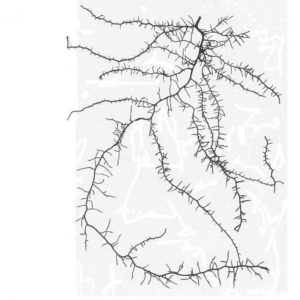 | Jaloviar, P; Jarčuška, B; Sarvašová, I Folia Oekologica, 35 (2) , pp. 25-32, 2008. @article{Jaloviar2008, title = { Influence of substrate kind and cultivation technology on quantitative characteristic of spruce (Picea abies (L.) Karst.) seedlings´ root systems: comparison between quantitative traits.}, author = {P. Jaloviar and B. Jarčuška and I. Sarvašová }, url = {http://ife.sk/wp-content/uploads/2016/10/FO_35_2_jaloviar.pdf}, year = {2008}, date = {2008-01-01}, journal = {Folia Oekologica}, volume = {35 (2)}, pages = {25-32}, abstract = {This work deals with evaluation of influence of four different management methods and substrate types on basic quantitative parameters of root systems in one-year old spruce (Picea abies (L.) Karst.) seedlings. There were tested differences between three alternatives consisting of bare-rooted plants and one variant of ball plants grown under applying the technique Lännen Plantek. The bare-rooted seedlings were cultivated in pure peat substrate (control) and in peat substrates supplemented with alginite and Baktomix. The tested traits were the following: root system weight, length, surface, volume, mean diameter and number of endings. For testing differences between the mean values of these characteristics, we used variance analysis. There has been found that in all the evaluated traits, the highest values were obtained with using the method Lännen Plantek. These values were several times higher that the next lower value. The variability of the measured values was about 30%. The lowest mean values were obtained in case of the peat substrate enriched with alginite. There is supposed that alginite caused water-logging of substrate and significantly retarded growth under the wetting regime favourable for all the other variants.}, keywords = {}, pubstate = {published}, tppubtype = {article} } This work deals with evaluation of influence of four different management methods and substrate types on basic quantitative parameters of root systems in one-year old spruce (Picea abies (L.) Karst.) seedlings. There were tested differences between three alternatives consisting of bare-rooted plants and one variant of ball plants grown under applying the technique Lännen Plantek. The bare-rooted seedlings were cultivated in pure peat substrate (control) and in peat substrates supplemented with alginite and Baktomix. The tested traits were the following: root system weight, length, surface, volume, mean diameter and number of endings. For testing differences between the mean values of these characteristics, we used variance analysis. There has been found that in all the evaluated traits, the highest values were obtained with using the method Lännen Plantek. These values were several times higher that the next lower value. The variability of the measured values was about 30%. The lowest mean values were obtained in case of the peat substrate enriched with alginite. There is supposed that alginite caused water-logging of substrate and significantly retarded growth under the wetting regime favourable for all the other variants. |
